
- my account Sign in Register

Cruise Switches
At The Cruise Control Store, we’re proud to offer after market cruise control kits, but if you need just the cruise control switch, we have those too. We offer an array of different universal switches, so no matter what type of vehicle you drive, you’ll be able to find just what you need in our inventory.
Why Choose a Cruise Control Switch from Us?
At The Cruise Control Store, we offer an inventory with an array of products to suit many different needs. For instance, one car from GM will require a different cruise control switch than a similar car from Ford. For that reason, we offer many different types of cruise control switch, including brushed aluminum and polished aluminum, left-side mount and right-side mount, adjustable switches, and universal switches. Depending on what type of vehicle you drive, we at The Cruise Control Store will be able to recommend a certain cruise control switch that will be most compatible with your vehicle.
About The Cruise Control Store
For more than 25 years, we have provided aftermarket cruise control kits for a number of different makes, including Ford, Honda, GMC, Mitsubishi, Nissan, Toyota, Jeep, and more. Our cruise control switch selection also offers our customers a number of choices. For more information about adding cruise control to your vehicle, contact us today.
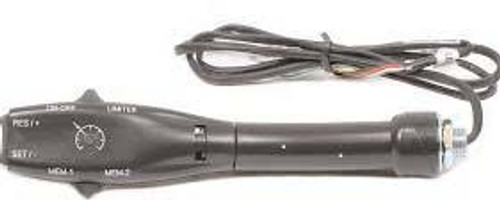
250-2867 Rostra cruise switch with Speed Limiter + Memory

Brushed aluminum Cover for 250-3020 / 3026 cruise switch

Polished aluminum Cover for 250-3020 / 3026 cruise switch

250-3026 Gm style Cruise Switch 1978-1984 No Wiper Control

250-3357 GM With Delay Wipers Cruise Control Switch
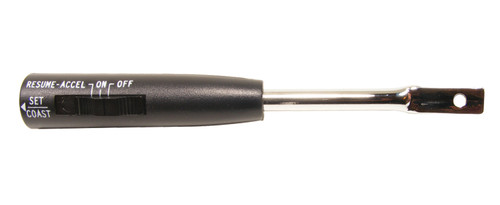
250-3020 Early Model GM Column Cruise Control Switch
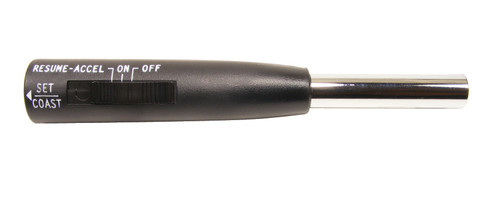
250-3032 "Cut Off" Universal Cruise Control Switch

250-3421 Universal Left Mount Column Cruise Control Switch
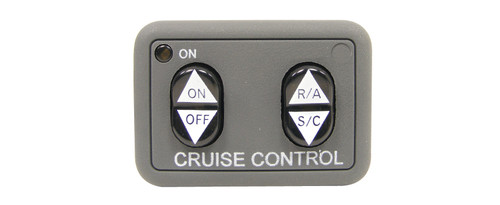
250-3593 Universal Cruise Control Switch Dash Mount Without Engage light

250-3592 Universal Cruise Control Switch Dash Mount With Engage light

250-3743 Universal Cruise Control Switch Column Mount Right Side
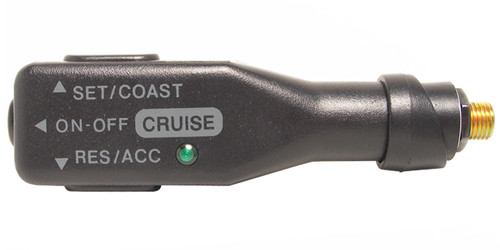
250-3742 Universal Cruise Control Switch Column Mount Left Side
The 250-2867 cruise control switch is the control switch included in Rostra's "NS" kits. This switch cannot be used on non "NS" kits. It is for replacing a defective ONLY.
This is a brushed aluminum cover for the 250-3020 cruise switch. This part is also offered in a polished alumninum finish. Please choose the correct option for your interior trim.
This is polished aluminum cover for the 250-3020 cruise switch. This part is also offered in a brushed alumninum finish. Please choose the correct option for your interior trim.
The 250-3026 is a GM style cruise control switch that is applicable to some 1978-1984 vehicles. If you have a lever that removes from the column by simply pulling it outwards, and has no wiper controls, this is the switch you need. Not compatible with...
The 250-3357 cruise switch is designed to replace your original turn signal lever with delay wiper control only when using the Rostra Universal Cruise Control. Please call with any questions regarding application. *** WILL NOT REPLACE YOUR...
The 250-3020 cruise control switch is applicable to early model GM columns. If the end of your rounded GM turn signal is flat, and is held in by a single set screw, then this may be the switch you need. Please call for application questions. This switch...
The 250-3032 is a universal cruise control switch that mounts to the vehicles existing turn signal lever. You will have to sever the end of the original turn signal lever, and slide the 3032 over the original turn signal shaft. To be used in conjunction...
The 250-3421 is a universal cruise control switch that mounts to the plastic shroud that surrounds the steering column, on the left hand side. It has an on/off, set and resume button. It is a "closed circuit" control switch designed to be used...
This is a universal cruise control switch that flush mounts on your dash or any flat surface. It has an on/off, set and resume button. This switch has a backlighting circuit that you can interface into the vehicles backlighting, or wire directly to...
This is a universal cruise control switch that flush mounts on your dash or any flat surface. It has an on/off, set and resume button as well as an "engage light". When connected to the 250-1223's engage output ( relay required, not included ) the light...
This is a universal cruise control switch that mounts on the right hand side of the steering column. It attaches to the plastic shroud that surrounds the column. The 250-3743 has a green L.E.D on/off indicator light as well as separate on/off,...
This is a universal cruise control switch that mounts on the left hand side of the steering column. It attaches to the plastic shroud that surrounds the column. The 250-3742 has a green L.E.D on/off indicator light as well as separate on/off, set...
© 2024 The Cruise Control Store Powered by BigCommerce All rights reserved. | Sitemap
- PRO Courses Guides New Tech Help Pro Expert Videos About wikiHow Pro Upgrade Sign In
- EDIT Edit this Article
- EXPLORE Tech Help Pro About Us Random Article Quizzes Request a New Article Community Dashboard This Or That Game Popular Categories Arts and Entertainment Artwork Books Movies Computers and Electronics Computers Phone Skills Technology Hacks Health Men's Health Mental Health Women's Health Relationships Dating Love Relationship Issues Hobbies and Crafts Crafts Drawing Games Education & Communication Communication Skills Personal Development Studying Personal Care and Style Fashion Hair Care Personal Hygiene Youth Personal Care School Stuff Dating All Categories Arts and Entertainment Finance and Business Home and Garden Relationship Quizzes Cars & Other Vehicles Food and Entertaining Personal Care and Style Sports and Fitness Computers and Electronics Health Pets and Animals Travel Education & Communication Hobbies and Crafts Philosophy and Religion Work World Family Life Holidays and Traditions Relationships Youth
- Browse Articles
- Learn Something New
- Quizzes Hot
- This Or That Game
- Train Your Brain
- Explore More
- Support wikiHow
- About wikiHow
- Log in / Sign up
- Cars & Other Vehicles
- Driving Vehicles
- Efficient Driving
How to Use Cruise Control on a Car
Last Updated: February 20, 2024 Fact Checked
This article was co-authored by Simon Miyerov . Simon Miyerov is the President and Driving Instructor for Drive Rite Academy, a driving academy based out of New York City. Simon has over 8 years of driving instruction experience. His mission is to ensure the safety of everyday drivers and continue to make New York a safer and efficient driving environment. This article has been fact-checked, ensuring the accuracy of any cited facts and confirming the authority of its sources. This article has been viewed 482,223 times.
Many cars come with cruise control systems, a great feature that will automatically keep a car driving at a set speed. This gives your feet a rest, and helps you save gas and avoid speeding tickets. Familiarize yourself with your car's cruise control switches, located on or near the steering wheel. Make sure to use cruise control only in safe conditions, and to stay focused on the road. Once you know how to operate cruise control, you're ready for a comfortable, efficient drive!
Get Car Support Solve Any Problem
We’re sorry we don’t support the car you are looking for. Please enter its make, model, and year below so that we can add support for it.
Operating Cruise Control

- Check your car's operating manual if you are unable to find the cruise control switches.

- Many cars have additional buttons to increase or decrease speed (marked by a +/-) when using cruise control.

- For some car models, cruise control will not operate below a certain speed, such as 40 miles (64 km) per hour.

- To stop cruise control briefly (such as when a car in front of you brakes), just press the brake as you normally would.
- If you are driving a manual, you can also disengage cruise control by pressing the clutch.
- If you are completely done using cruise control, you can press the “OFF” or "ON/OFF" switch.
- If your car has a cruise control “CANCEL” switch, you can also press that to stop it.

- If your car has a +/- button for cruise control, press this when you want to raise or lower your car's speed.
Using Cruise Control Safely and Efficiently

- Using cruise control on busy streets can also be dangerous. Since you yourself are not in complete control of your car, you may be paying less attention. You might brake or react to other cars more slowly than normal, increasing the chance of an accident.

- Wet or snowy roads
- Hilly, steep, or mountainous areas
- Winding roads

Expert Q&A

You Might Also Like

- ↑ Simon Miyerov. Driving Instructor. Expert Interview. 4 December 2019.
- ↑ https://www.youtube.com/watch?v=jKtBSFoAYlg
- ↑ http://www.thecarexpert.co.uk/cruise-control/
About This Article

If you want to use cruise control on your car, make sure you're on the open road, such as a freeway or highway. Additionally, avoid using cruise control in rainy or snowy conditions, or if you're driving through a city, since you'll need to change speed and turn regularly. When you're ready to switch to cruise control, press the "Set" switch, which is usually found on the steering column or on the wheel, when your car reaches the desired speed. To stop cruise control, press on the brake or push the clutch if you're driving a manual car. To learn when to avoid using cruise control and how it can help you save on fuel, read on! Did this summary help you? Yes No
- Send fan mail to authors
Reader Success Stories
Joseph Adizero
Dec 17, 2020
Did this article help you?
Suraj Sinha
Jun 17, 2016
Ashish Vohra
Oct 17, 2017
Jul 26, 2017
Alejandro Martinez
Jul 25, 2016

Featured Articles

Trending Articles

Watch Articles

- Terms of Use
- Privacy Policy
- Do Not Sell or Share My Info
- Not Selling Info
Don’t miss out! Sign up for
wikiHow’s newsletter
Enter your email below to receive occasional updates in your inbox.
- < Back to email setting
Cruise Control: What It Is and How to Use It
How to use cruise control.
The location of the cruise control buttons can vary per car. For your car, check the manufacturer’s manual for the location and specific instructions. To set cruise control, press the ON/OFF button or switch. If you press this button again, it typically turns the system off. The Res + (resume / increase seed) button increases the cruising speed by 1 mph, while the Set – (set speed / reduce speed) button decreases it by 1 mph. To shut off the cruise control, you can press the Cancel button or simply press the brake pedal. [1]
What is cruise control?
Cruise control locks your car’s accelerator at a specific speed, allowing you to take your foot off the pedal and remain at a constant speed. Because it’s so convenient for commuters and drivers who use the highway frequently, cruise control is a feature that generally comes standard on most models of cars. [2]
What is adaptive cruise control?
Adaptive cruise control is very similar to conventional cruise control, only it automatically adjusts the speed of your vehicle depending on how fast the vehicle in front of you is going. It may also reduce your speed around tight curves and adjust to speed limit changes, depending on your car’s technology. [3]
How to set cruise control
Follow these steps when setting the cruise control:
- Evaluate weather conditions: Check for hazardous weather conditions and any oncoming obstacles before applying cruise control.
- Build your speed: The ideal speed for cruise control is between 55 and 70 mph.
- Turn cruise control on: The button is usually on or near your steering wheel.
- Set cruise control: Press another button on your steering wheel and remove your foot from the accelerator.
- Watch the road carefully: You will have a slower reaction time if your foot is off of the brake or accelerator pedal. [1]
How does cruise control work?
Cruise control adjusts the throttle position in your car to control your speed. It does this by a cable connected to an actuator, instead of just by pressing the pedal to adjust the speed. [4]
Cruise control safety tips
Follow these safety tips while using cruise control on the road:
- Use it only on highways: Roads with lower speeds often have traffic lights, turns and other cars that require frequent stops.
- Don’t use it in heavy traffic: If you hit traffic and use the brakes a lot, cruise control isn’t ideal.
- Don’t use it on wet streets: Wet roads are dangerous, and it’s important to keep control of your car and its speed in those conditions.
- Keep your distance from other cars: A set speed could cause you to get dangerously close to other vehicles. Not every car as the distance-monitoring system that adjusts your car’s speed based on what’s in front of you.
- Hover your foot over the brake: Always be prepared to break whenever necessary.
- Be aware of your surroundings: Look out for other cars on the road and stay in your lane. [5]
Cruise control when it’s raining
Avoid using cruise control when the roads are wet . You might not be able to stop as quickly as you’d like when using cruise control. This could lead to dangerous situations and even accidents. Wet roads can affect your car’s ability to maintain a constant speed. There’s even a possibility if you’re using cruise control while it’s raining that your vehicle could hydroplane . [6]
Frequently asked questions about cruise control
Does cruise control save gas.
Cruise control can help you save an average of 7% to 14% on gas. When you don’t use cruise control and constantly press the accelerator and brake pedals, more gas is usually used. Cruise control works best to save gas when driving on flat roads that are free of congestion. [7]
Is cruise control bad for your card?
In general, cruise control isn’t bad for your car. It can actually reduce heavy acceleration and deceleration. It doesn’t damage your car in any way, and the frequent use of it doesn’t affect your vehicle. [8]
Is cruise control safe?
Cruise control is convenient for long stretches of driving and it can keep you from speeding if you set your speed to the correct limit. However, if the road conditions are rainy or snowy, cruise control can be dangerous. To use cruise control safely, it’s best to know when you should and shouldn’t use it. [9] Using cruise control on the highway makes your driving more predictable to other drivers. Instead of constantly changing speeds, cars know how fast you’re driving and can follow safely behind you or pass.
When should cruise control not be used?
You shouldn’t use cruise control in the following conditions:
- When the roads are wet and slippery.
- During heavy traffic.
- On hills and winding roads. [9]
[1] “What is cruise control?” kia.com/dm/discover-kia/ask/what-is-cruise-control.html (accessed July 11, 2023).
[2] “How to Use Cruise Control: 7 Specific Things You Need to Know Well,” driving-tests.org/beginner-drivers/how-to-use-cruise-control (accessed July 11, 2023).
[3] “What Is Adaptive Cruise Control? Is It Worth Paying For?” Stefan Ogbac, motortrend.com/features/adaptive-cruise-control (accessed June 2, 2020).
[4] “How Cruise Control Systems Work,” Karim Nice auto.howstuffworks.com/cruise-control.htm (accessed Feb. 9, 2021).
[5] “6 Cruise Control Safety Tips You Should Never Ignore,” Marisol Pereira and Carrie Adkins, getjerry.com/advice/6-cruise-control-safety-tips-you-should-never-ignore-by-marisol-pereira (accessed April 27, 2022).
[6] “How Does the Cruise Control in Cars Work?” mapfreinsurance.com/blog/how-does-cruise-control-in-cars-work (accessed July 11, 2023).
[7] “Does cruise control save gas?” kia.com/dm/discover-kia/ask/does-cruise-control-save-gas.html (accessed July 11, 2023).
[8] “Everything You Need to Know about Cruise Control,” Dave Johnston, mycarmakesnoise.com/electronics/cruise-control-guide (accessed July 11, 2023).
[9] “Is Cruise Control Safe to Use?” kaufmanlawatlanta.com/is-cruise-control-safe-to-use (accessed July 11, 2023).
Disclaimer:
The information included here is designed for informational purposes only. It is not legal, tax, financial or any other sort of advice, nor is it a substitute for such advice. The information may not apply to your specific situation. We have tried to make sure the information is accurate, but it could be outdated or even inaccurate in parts. It is the reader’s responsibility to comply with any applicable local, state or federal regulations. Nationwide Mutual Insurance Company, its affiliates and their employees make no warranties about the information nor guarantee of results, and they assume no liability in connection with the information provided. Nationwide and the Nationwide N and Eagle are service marks of Nationwide Mutual Insurance Company. © 2024 Nationwide
Related articles
Tire rotation overview: why and when to do it.
Keeping your tires in good condition can be the difference between a safe ride and an accident. If your tires wear or get misaligned over time, this can lead to...
Why Are My Brakes Making Noise?
Have you ever been confused as to the sounds coming from your vehicle when you brake? From grinding and rattling to thumping and squealing, you can learn how to decode...
12 Common Car Noises and What They Mean
One minute you’re driving your car and everything seems fine, and the next moment you hear a strange noise coming from your car as you accelerate. There are some normal...
- What's My Car Worth?
- Buyer's Guide
How to Use Cruise Control Safely
Everything you need to know for safe, stress-free driving with your car's cruise-control system.

Its Job Is to Maintain Speed
Cruise control's primary function is to maintain the speed of your choosing, relieving you of needing to keep your foot on the throttle. Virtually all cars on the road today rely on an electronic control module—a computer—to monitor the vehicle's speed and to readjust it as needed to hold the speed you've chosen regardless of the road's gradient.

Know the Controls
You operate cruise control by either a stalk on the steering column or several buttons on the steering wheel. These include an on-off switch; a "set" button to select the speed you want the car to maintain; and buttons or switches marked "+" and "—" that increase or decrease the speed after it has been set, often in 1-mph increments. A "cancel" button disengages the cruise-control system without shutting it off entirely, allowing the car to coast. (Cars with stalk-operated cruise control have a "cancel" position that you move the stalk to in order to disengage the system.) A "resume" function or button brings the car back to its previously set speed. Braking or depressing the clutch at any time will also cancel cruise control. Should you need to make a quick pass, you can always override the preset speed by simply pressing down further on the gas pedal.
Adaptive Cruise's Added Features
Many newer cars offer what's known as adaptive cruise control, sometimes also called active cruise. It works in the same way as conventional cruise systems and additionally relies on front-mounted radar , cameras, or sensors to detect the presence of vehicles directly ahead in your lane. This enables adaptive cruise-control systems to maintain a set distance from the vehicle in front no matter how it varies its speed.
Adaptive systems allow you to adjust how closely your vehicle follows the one ahead but are programmed so that they always maintain at least a safe minimum following distance. Some of these systems also have the ability to brake and even come to a complete stop in city traffic and, depending on the vehicle, automatically accelerate without the driver pressing the gas pedal when traffic starts to move again.
Semi-Autonomous Cruise Control
Finally, the newest, most advanced cruise control systems, such as such as Nissan ProPilot Assist, Subaru EyeSight, and Audi Traffic Jam Assist, are semi-automated driving assistants that combine adaptive cruise control with lane-keeping assist, which self-steers the car gently to keep it in lane if you let it wander out—although you can only take your hands off the wheel for a few seconds before the system sounds alarms and then shuts off.
.css-1rvrtxn{font-family:Gliko,Gliko-fallback,Gliko-roboto,Gliko-local,Georgia,Times,Serif;font-size:1.625rem;line-height:1.2;margin:0rem;-webkit-text-decoration:underline;text-decoration:underline;text-decoration-color:#DBCA8B;text-decoration-thickness:0.25rem;}@media(max-width: 48rem){.css-1rvrtxn{font-size:2.25rem;line-height:1.1;}}@media(min-width: 48rem){.css-1rvrtxn{font-size:2.625rem;line-height:1.1;}}@media(min-width: 64rem){.css-1rvrtxn{font-size:3rem;line-height:1.1;}}.css-1rvrtxn b,.css-1rvrtxn strong{font-family:inherit;font-weight:bold;}.css-1rvrtxn em,.css-1rvrtxn i{font-style:italic;font-family:inherit;} No matter what type of cruise control your car has, the rules for using it safely are the same.
Most of these systems also can autonomously negotiate only the most gentle curves on the interstate. Some semi-autonomous systems, such as those from Tesla and Mercedes-Benz , can do more, including steering the car into the adjacent lane while keeping enough distance from other cars.
Follow These Safety Rules
No matter which type of cruise control your car has, the guidelines for using it effectively and safely are the same:
- Always remain alert and aware of other traffic, and be ready to take control and brake or steer around obstacles, inattentive drivers, or emergency situations.
- Think of even the most advanced adaptive and semi-autonomous cruise control systems as "dumb." They are programmed by humans and may react unpredictably in certain, unforeseen conditions. (See previous point: "remain alert.") Rain, snow, and fog can obscure radar signals and confuse cameras or sensors, sometimes disabling adaptive cruise control entirely. As with conventional cruise control, with an advanced cruise system you must always be prepared to take full control at a moment's notice.
- Cruise control is still best suited for use on highways and in light traffic. If your vehicle has conventional (not adaptive) cruise control, be sure to leave adequate spacing between your car and those ahead, and be prepared to disengage the system by braking or tapping "cancel" as you creep up on other vehicles or get into heavy traffic.
- Do not use cruise control in slippery conditions, including snowy or icy roads or rain-soaked roads awash in deep puddles. Most cruise systems will attempt to maintain your speed until you intervene, and on slippery roads that could cause you to momentarily lose traction, upsetting the car and potentially precipitating an accident.
Treat cruise control as a simple labor-saving convenience, however—but one that must be monitored—and you'll enjoy many miles of comfortable, stress-free travel.
Clifford Atiyeh is a reporter and photographer for Car and Driver , specializing in business, government, and litigation news. He is president of the New England Motor Press Association and committed to saving both manuals and old Volvos.

.css-1updq97:before{background-color:#000000;color:#fff;left:0;width:50%;border:0 solid transparent;bottom:48%;height:0.125rem;content:'';position:absolute;z-index:-2000000;} Features .css-1e2ieb7:after{background-color:#000000;color:#fff;right:0;width:50%;border:0 solid transparent;bottom:48%;height:0.125rem;content:'';position:absolute;z-index:-2000000;}

How to Change Your Oil

Trucks and SUVs with Manual Transmissions
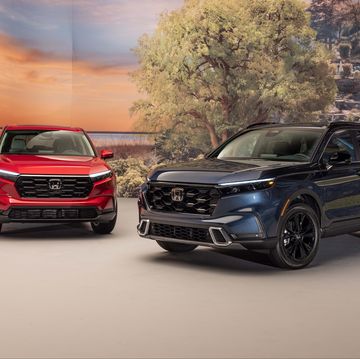
Gasoline vs. Hybrid Cars: Pros and Cons of Each

What's a Hydrogen Fuel-Cell Vehicle Anyway?
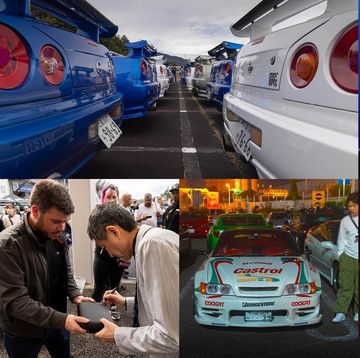
A Fast Tour of Japan's Car Culture
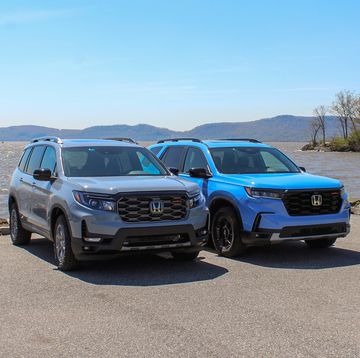
Pilot vs. Passport: Comparing Honda SUVs

The Winningest Cars in 10Best History
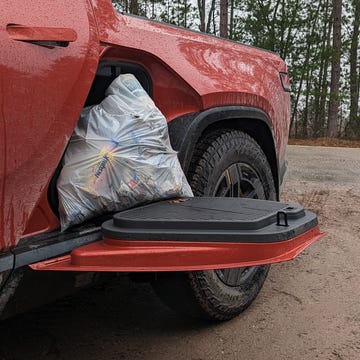
We Fill a Rivian R1T with Garbage for Earth Day

Most Fuel-Efficient Gas Cars (That Aren't Hybrid)
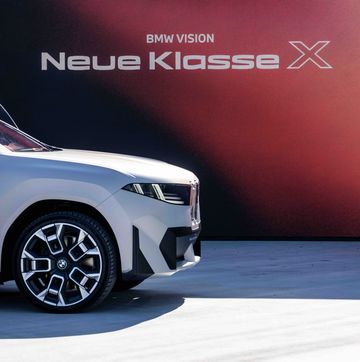
BMW Puts Brains on the Menu with Neue Klasse

The Best Odds: Alfa Romeo Milano

CarParts.com will be back soon!
We apologize for the inconvenience. The CP Team is working on some upgrades to improve our service. Thank you for using CarParts.com!
You can call us at
1-866-529-0412
Reference ID: 18.6fc733e.1714815642.f962e17
Advertisement
How Cruise Control Systems Work
- Share Content on Facebook
- Share Content on LinkedIn
- Share Content on Flipboard
- Share Content on Reddit
- Share Content via Email
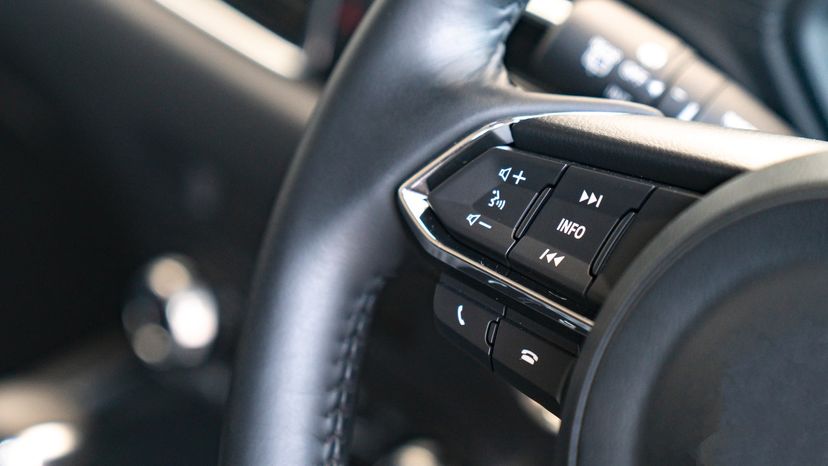
Cruise control is an invaluable feature on American cars. Without cruise control, long road trips would be more tiring, for the driver at least, and those of us suffering from lead-foot syndrome would probably get a lot more speeding tickets.
Cruise control is far more common on American cars than European cars, because the roads in America are generally bigger and straighter, and destinations are farther apart. With traffic continually increasing, basic cruise control is becoming less useful, but instead of becoming obsolete, cruise control systems are adapting to this new reality -- soon, cars will be equipped with adaptive cruise control, which will allow your car to follow the car in front of it while continually adjusting speed to maintain a safe distance.
In this article, we'll learn how a conventional cruise control system works, and then we'll take a look at adaptive cruise control systems that are under development.
What Cruise Control Does
Cruise control acceleration and deceleration, controlling the cruise control, adaptive cruise control.
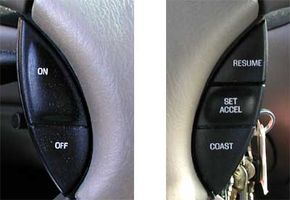
The cruise control system actually has a lot of functions other than controlling the speed of your car. For instance, the cruise control pictured below can accelerate or decelerate the car by 1 mph with the tap of a button. Hit the button five times to go 5 mph faster. There are also several important safety features -- the cruise control will disengage as soon as you hit the brake pedal, and it won't engage at speeds less than 25 mph (40 kph).
The system pictured below has five buttons: On, Off, Set/Accel, Resume and Coast. It also has a sixth control -- the brake pedal, and if your car has a manual transmission the clutch pedal is also hooked up to the cruise control.
- The on and off buttons don't actually do much. Hitting the on button does not do anything except tell the car that you might be hitting another button soon. The off button turns the cruise control off even if it is engaged. Some cruise controls don't have these buttons; instead, they turn off when the driver hits the brakes, and turn on when the driver hits the set button.
- The set/accel button tells the car to maintain the speed you are currently driving. If you hit the set button at 45 mph, the car will maintain your speed at 45 mph. Holding down the set/accel button will make the car accelerate; and on this car, tapping it once will make the car go 1 mph faster.
- If you recently disengaged the cruise control by hitting the brake pedal, hitting the resume button will command the car to accelerate back to the most recent speed setting.
- Holding down the coast button will cause the car to decelerate, just as if you took your foot completely off the gas. On this car, tapping the coast button once will cause the car to slow down by 1 mph.
- The brake pedal and clutch pedal each have a switch that disengages the cruise control as soon as the pedal is pressed, so you can shut off the cruise control with a light tap on the brake or clutch.
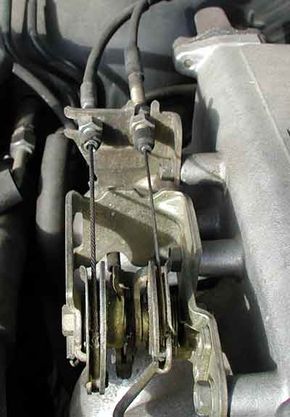
The cruise control system controls the speed of your car the same way you do -- by adjusting the throttle position . But cruise control actuates the throttle valve by a cable connected to an actuator , instead of by pressing a pedal. The throttle valve controls the power and speed of the engine by limiting how much air the engine takes in (see How Fuel Injection Systems Work for more details).
In the picture above, you can see two cables connected to a pivot that moves the throttle valve. One cable comes from the accelerator pedal, and one from the actuator. When the cruise control is engaged, the actuator moves the cable connected to the pivot, which adjusts the throttle; but it also pulls on the cable that is connected to the gas pedal -- this is why your pedal moves up and down when the cruise control is engaged.
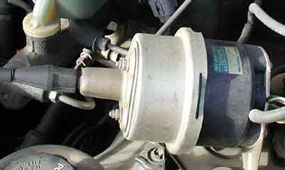
Many cars use actuators powered by engine vacuum to open and close the throttle. These systems use a small, electronically-controlled valve to regulate the vacuum in a diaphragm. This works in a similar way to the brake booster , which provides power to your brake system.
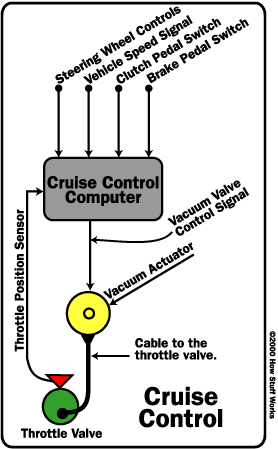
The brain of a cruise control system is a small computer that is normally found under the hood or behind the dashboard. It connects to the throttle control seen in the previous section, as well as several sensors. The diagram below shows the inputs and outputs of a typical cruise control system.
A good cruise control system accelerates aggressively to the desired speed without overshooting, and then maintains that speed with little deviation no matter how much weight is in the car, or how steep the hill you drive up. Controlling the speed of a car is a classic application of control system theory . The cruise control system controls the speed of the car by adjusting the throttle position, so it needs sensors to tell it the speed and throttle position. It also needs to monitor the controls so it can tell what the desired speed is and when to disengage.
The most important input is the speed signal; the cruise control system does a lot with this signal. First, let's start with one of the most basic control systems you could have -- a proportional control .
In a proportional control system, the cruise control adjusts the throttle proportional to the error, the error being the difference between the desired speed and the actual speed. So, if the cruise control is set at 60 mph and the car is going 50 mph, the throttle position will be open quite far. When the car is going 55 mph, the throttle position opening will be only half of what it was before. The result is that the closer the car gets to the desired speed, the slower it accelerates. Also, if you were on a steep enough hill, the car might not accelerate at all.
Most cruise control systems use a control scheme called proportional-integral-derivative control (a.k.a. PID control). Don't worry, you don't need to know any calculus to make it through this explanation -- just remember that:
- The integral of speed is distance.
- The derivative of speed is acceleration.
A PID control system uses these three factors -- proportional, integral and derivative, calculating each individually and adding them to get the throttle position.
We've already discussed the proportional factor. The integral factor is based on the time integral of the vehicle speed error . Translation: the difference between the distance your car actually traveled and the distance it would have traveled if it were going at the desired speed, calculated over a set period of time. This factor helps the car deal with hills, and also helps it settle into the correct speed and stay there. Let's say your car starts to go up a hill and slows down. The proportional control increases the throttle a little, but you may still slow down. After a little while, the integral control will start to increase the throttle, opening it more and more, because the longer the car maintains a speed slower than the desired speed, the larger the distance error gets.
Now let's add in the final factor, the derivative . Remember that the derivative of speed is acceleration. This factor helps the cruise control respond quickly to changes, such as hills. If the car starts to slow down, the cruise control can see this acceleration (slowing down and speeding up are both acceleration) before the speed can actually change much, and respond by increasing the throttle position.
Two companies are developing a more advanced cruise control that can automatically adjust a car's speed to maintain a safe following distance. This new technology, called adaptive cruise control , uses forward-looking radar , installed behind the grill of a vehicle, to detect the speed and distance of the vehicle ahead of it.
Adaptive cruise control is similar to conventional cruise control in that it maintains the vehicle's pre-set speed. However, unlike conventional cruise control, this new system can automatically adjust speed in order to maintain a proper distance between vehicles in the same lane. This is achieved through a radar headway sensor , digital signal processor and longitudinal controller . If the lead vehicle slows down, or if another object is detected, the system sends a signal to the engine or braking system to decelerate. Then, when the road is clear, the system will re-accelerate the vehicle back to the set speed.
The 77-GHz Autocruise radar system made by TRW has a forward-looking range of up to 492 feet (150 meters), and operates at vehicle speeds ranging from 18.6 miles per hour (30 kph) to 111 mph (180 kph). Delphi's 76-GHz system can also detect objects as far away as 492 feet, and operates at speeds as low as 20 mph (32 kph).
Adaptive cruise control is just a preview of the technology being developed by both companies. These systems are being enhanced to include collision warning capabilities that will warn drivers through visual and/or audio signals that a collision is imminent and that braking or evasive steering is needed.
For more information on cruise control, check out the links below.
Cruise Control FAQ
How does cruise control work, how does adaptive cruise control work, will adaptive cruise control stop the vehicle, when would you use cruise control, how useful is cruise control, lots more information, related articles.
- How Car Engines Work
- How Brakes Work
- How Manual Transmissions Work
- How Fuel Injection Systems Work
- How Radar Detectors Work
- Ignition System Quiz
More Great Links
- BMW: Cruise-control-equipped motorcycle
- Cruise Control Block Diagram
- Cruise Control Installers' Instructions
- Cruise Control Service Tips
Please copy/paste the following text to properly cite this HowStuffWorks.com article:
Cruise Control In Cars Explained (And How To Safely Use It)

Have you ever wished you could set your car's speed and just sit back and relax while driving on a long stretch of highway? If that's the case, then cruise control is just the ticket you've been searching for—and the good news is, it's a standard feature in most cars these days!
Cruise control is a handy feature for drivers that allows you to maintain a constant speed without having to keep your foot on the gas pedal. In this post, we'll explore how cruise control works, its benefits, and how to use it safely to make your driving experience more comfortable.
Understanding Cruise Control
Cruise control, also known as speed control, is an electronic system that allows you to maintain a specific speed without manually controlling the accelerator pedal. The system uses sensors and electronic components to control the throttle and keep your car moving at a desired speed. First introduced in the late 1950s, cruise control has since become a standard feature in most modern vehicles you see on the road today.
How Does It Work?
At its core, cruise control involves a series of sensors that monitor the vehicle's speed and a control unit that regulates the throttle. When the driver sets the cruise control to a specific speed, the system adjusts the throttle to maintain that speed. If the car begins to slow down because of an incline (e.g. going up a hill), the system will open the throttle to accelerate. Conversely, if the car starts to speed up due to a declin (e.g. going downhill), the system will close the throttle to decelerate.
Modern cruise control systems also come with additional features like adaptive cruise control (ACC), which uses radar or cameras to detect vehicles ahead and automatically adjusts the speed to maintain a safe following distance (more on this BELOW).
The History of Cruise Control
The invention of cruise control can be traced back to the late 1940s and early 1950s, when engineer Ralph Teetor developed the first-speed control system. This innovative feature was designed to help drivers maintain a steady speed, reduce fatigue while driving, and improve fuel efficiency. Over the years, cruise control technology has undergone significant advancements, leading to the development of sophisticated systems like adaptive cruise control.
Types of Cruise Control Systems
Today, drivers can choose from a range of cruise control systems, each with its own unique features and functionalities.
Conventional Cruise Control
Conventional cruise control is like your old reliable friend. It's pretty basic and doesn't have any fancy bells and whistles. You just set the speed you want, and it'll keep your car cruising along at that speed, no problem. It's perfect for those long drives on open highways, but it doesn’t automatically react to other cars on the road.
So, if the car in front of you slows down, you'll need to step in and adjust your speed manually. This trusty system comes standard on most cars and is great for saving some fuel on those long road trips .
Adaptive Cruise Control (ACC)
Now, if conventional cruise control is your old reliable friend, then Adaptive Cruise Control (ACC) is like that friend's tech-savvy younger cousin. ACC isn't just maintaining your set speed, it's also keeping an eye on the car in front of you. If that car slows down, ACC slows your car down to keep a safe distance .
It's like having an extra set of eyes on the road, making highway driving a breeze. Plus, some ACC systems can even handle stop-and-go traffic, bringing your car to a full stop and then picking up speed again when traffic gets moving.
Predictive Cruise Control
Predictive Cruise Control is like the fortune teller of cruise control systems. It uses GPS and map data to see into the future and predict what's coming up on the road, like hills or curves, and adjusts your speed accordingly. This means you get a smoother ride and better fuel efficiency, but it all depends on the quality of the GPS and map data. If that's a bit out of date, your fortune-telling cruise control might not be so accurate. It's usually found in more high-end vehicles where top-notch fuel efficiency is a focus for the engineers.
Cooperative Adaptive Cruise Control (CACC)
And then we have Cooperative Adaptive Cruise Control, or CACC. This is like the team player of cruise control systems. It allows cars to talk to each other, coordinating their speeds to maintain a safe distance. It's like having a well-coordinated team of cars all working together to make the traffic flow smoother and reduce congestion. Picture it like a synchronized dance on the highway, where every car knows its place and keeps the right distance. This tech is still pretty new, but it's got a lot of potential. Imagine a future where traffic jams could be a thing of the past.
Remember, these systems are here to make your drive smoother and safer, but they're not a replacement for your attention. No matter how fancy your cruise control is, these systems can be greatly influenced by external conditions like weather and traffic, and they should always be used as aids, not replacements, for attentive driving.
Common Cruise Control Symbols and Indicators
Understanding the various symbols and indicators associated with cruise control is important for safe and effective usage. These symbols typically appear on the dashboard (or on the side of the steering wheel) and may include a speedometer icon, "SET," "RES" (resume), and "CANCEL". Be sure to consult your vehicle's owner's manual for specific details and explanations of these symbols.
Benefits of Using Cruise Control
Cruise control offers several benefits to drivers, especially during long road trips or highway driving.
Fuel Efficiency
One of the main advantages of using cruise control is improved fuel efficiency. By maintaining a constant speed, cruise control helps reduce fuel consumption, leading to better gas mileage. Rapid acceleration and deceleration, on the other hand, can lead to increased fuel consumption.
Comfort and Convenience
Cruise control allows drivers to take their foot off the accelerator pedal, reducing fatigue and improving comfort during long drives. It also helps drivers avoid unintentionally exceeding the speed limit by setting a maximum speed.
When used correctly, cruise control can contribute to safer driving. By maintaining a steady speed, it reduces the likelihood of erratic driving behavior and potential accidents. However, it is important to note that cruise control shouldn't be used in certain conditions, such as heavy traffic or slippery roads .
Troubleshooting Common Cruise Control Issues
Occasionally, you may encounter issues with your cruise control systems. Common problems include cruise control not engaging or disengaging unexpectedly. Possible causes may include a faulty brake light switch, malfunctioning sensors, or issues with the control module. If you experience any problems with your cruise control, it's best to have a qualified technician diagnose and repair the issue for you.
Cruise Control and Road Etiquette
Practicing proper road etiquette while using cruise control is essential for a safe and pleasant driving experience. Here are some tips on how to use cruise control courteously:
- Avoid using cruise control in heavy or congested traffic, as it may hinder your ability to react quickly to changing conditions.
- Be mindful of other drivers when setting your speed. Avoid setting a speed that's significantly slower or faster than the flow of traffic.
- If you are in the passing lane and using cruise control, be sure to adjust your speed or temporarily disengage the system to allow faster-moving vehicles to pass.
- Always signal your intentions, such as lane changes or exiting the highway, even when using cruise control.
The Future of Cruise Control Technology
Cruise control technology plays a vital role in the development of autonomous vehicles, or self-driving cars . In autonomous vehicles, cruise control systems work together with other advanced driver assistance systems (ADAS) to enable the vehicle to operate without direct driver input. These systems include lane-keeping assist, automatic emergency braking, and collision avoidance systems.
As autonomous vehicles become more sophisticated, cruise control technology is evolving to support higher levels of automation. For example, some autonomous vehicles are equipped with advanced cruise control systems that can navigate complex traffic scenarios, merge onto highways, and even change lanes autonomously.
While fully autonomous vehicles are still in the developmental stages, the integration of cruise control technology is a big step toward creating safer and more efficient transportation systems.
As automotive tech continues to advance, cruise control systems are becoming more intelligent and capable. Here are some potential developments we can expect to see in the future of cruise control technology:
- Integration of artificial intelligence (AI) to improve decision-making and responsiveness in adaptive cruise control systems.
- Enhanced connectivity and vehicle-to-vehicle (V2V) communication, enabling cars to share information about traffic conditions and coordinate their speeds for smoother traffic flow.
- Greater customization and personalization options, allowing drivers to set preferences for cruise control behavior, such as following distance and speed adjustments.
Overall, the future of cruise control technology holds promise for creating a more seamless and enjoyable driving experience, with a focus on safety, comfort, and sustainability.
Debunking Myths About Cruise Control
Let's address and debunk some common misconceptions about cruise control:
Myth : Cruise control can be used as a substitute for driver attention.
Fact : Cruise control is a driver assistance feature, not a replacement for attentive driving. Drivers should always remain alert and ready to take control when necessary.
Myth : Cruise control increases the risk of accidents.
Fact : When used appropriately, cruise control can contribute to safer driving by maintaining a steady speed and reducing erratic driving behavior.
Cruise control is a valuable feature that can enhance your driving experience by providing comfort, convenience, and fuel efficiency. Remember to use it safely and appropriately based on driving conditions, and always stay attentive while on the road.
If you found this post informative and want to learn more about car features, driving tips, and automotive technology, be sure to subscribe to our newsletter for regular updates. We're here to help you stay informed and enhance your driving experience.
Frequently Asked Questions About Cruise Control
To further enhance your understanding of cruise control, here are answers to some common questions:
Q : Can cruise control be used in all weather conditions?
A : It isn't advisable to use cruise control in adverse weather conditions, such as heavy rain, snow, or icy roads, as it may reduce your ability to respond quickly to changing road conditions.
Q : Can I use cruise control in urban areas with frequent stop-and-go traffic?
A : Cruise control is best suited for open roads and highways with consistent traffic flow. It isn't recommended for use in urban areas with frequent stops or heavy traffic.
Q : Does cruise control work at any speed?
A : Cruise control typically has a minimum speed threshold, below which it can't be engaged. This threshold varies by vehicle, so check your owner's manual for specific information.
About the Author: This article was crafted by the LOOP Marketing Team. Comprising of seasoned professionals with expertise in the insurance industry, our team is dedicated to providing readers with accurate, up-to-date, and valuable information. At LOOP, we're passionate about helping families navigate the world of car insurance, ensuring they get the best coverage at the most affordable rates. Learn more about our mission and values here.
For more insights on auto insurance and other related topics, visit our blog .
Quick Navigation
Check out how much you could save today.
Browse related articles


What'S In Your Car? The Best Accessories To Get Before Hitting The Road
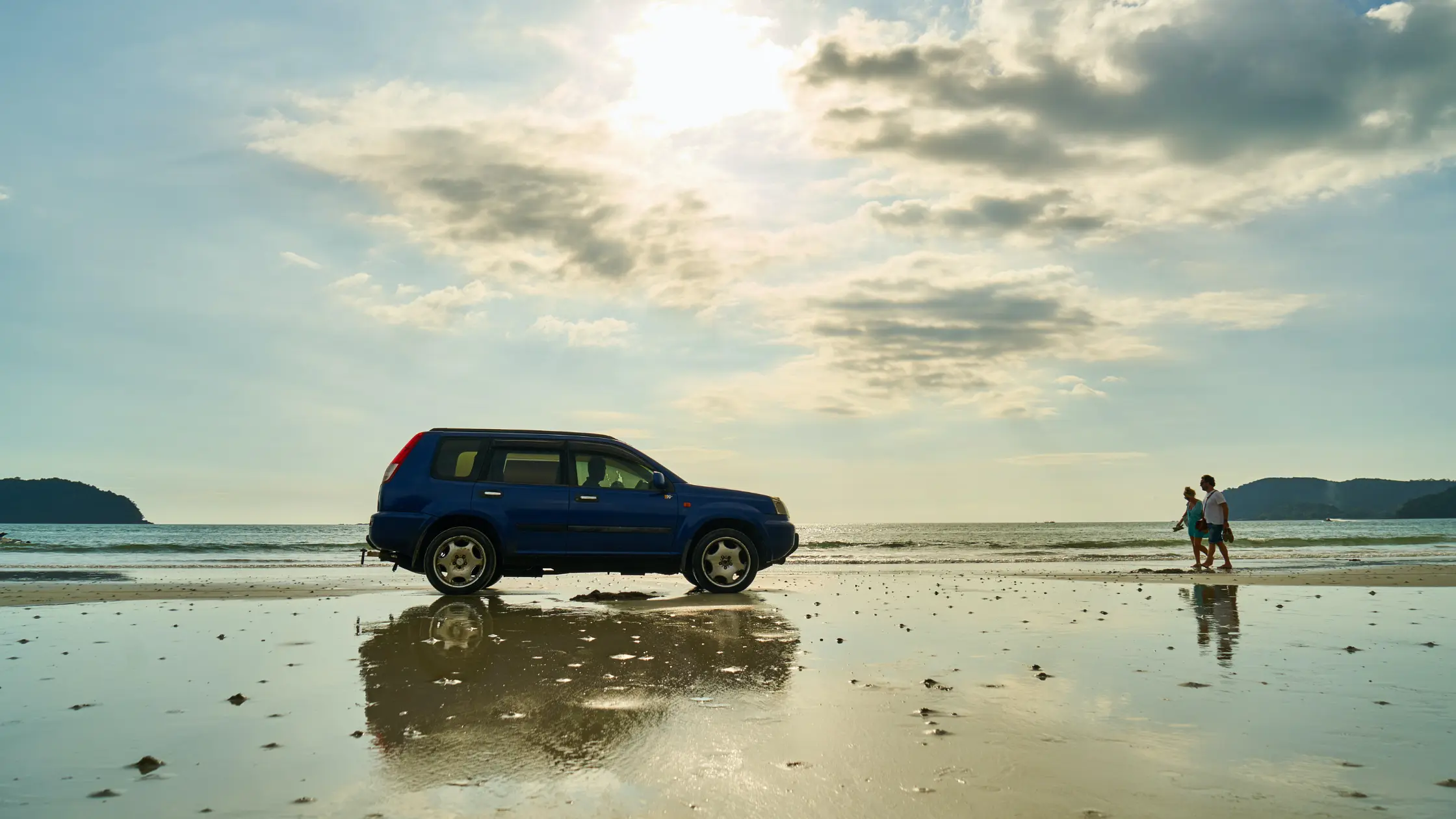
A Simple Guide On How To Plan A Road Trip In 2023

Shield Your Dash: Safeguarding Your Car from the Sun’s Stealthy Damage
Life has many roads. your weekly navigator is just a click away..

What is Cruise Control and How Does it Function in a Car?

A Quick Overview
Driving on long stretches of highway can be tiring, especially when trying to maintain a constant speed. Cruise control alleviates this by allowing drivers to set and maintain a desired speed without continuous use of the accelerator pedal. Understanding how cruise control functions can help drivers make the most of this convenient feature.
What is Cruise Control?
Cruise control is an automotive feature that enables drivers to set a desired speed for their vehicle. Once activated, the cruise control system maintains the set speed without the need for constant pedal input. It helps drivers maintain a steady pace on long trips, providing convenience and reducing the likelihood of unintentional speed fluctuations.
How Does Cruise Control Function?
Cruise control systems may vary slightly among different vehicle models, but they generally function using the following components and controls:
1. Set Button
To activate cruise control, the driver typically presses a “Set” button or engages a switch on the steering wheel or dashboard. This action captures the current speed of the vehicle and sets it as the target speed for the cruise control system to maintain.
2. Speed Control
Once the cruise control system is activated, the driver can adjust the speed using speed control buttons. These buttons allow the driver to increase or decrease the set speed in small increments. By pressing the appropriate button, the driver can fine-tune the desired speed for their comfort and road conditions.
3. Resume Button
The “Resume” button, also known as the “Accel” button, allows the driver to restore the previously set speed after it has been canceled or temporarily interrupted. When the driver presses the “Resume” button, the cruise control system accelerates the vehicle to the previously set speed.
4. Cancel Button
The “Cancel” button, often marked with the symbol “CRUISE” or “OFF,” deactivates the cruise control system. Pressing this button disengages the system and allows the driver to regain full control over acceleration and braking. It is important to note that the brake pedal can also automatically deactivate cruise control when pressed.
Advantages of Cruise Control
Cruise control offers several advantages to drivers:
- Reduced Driver Fatigue: Cruise control allows drivers to maintain a steady speed without continuously pressing the accelerator pedal, reducing fatigue on long drives.
- Improved Fuel Efficiency: By maintaining a consistent speed, cruise control can help optimize fuel efficiency by reducing unnecessary acceleration and deceleration.
- Avoiding Speeding: Cruise control helps drivers adhere to speed limits by maintaining a set speed, preventing unintentional speeding due to variations in foot pressure on the accelerator pedal.
Limitations of Cruise Control
While cruise control provides convenience, there are limitations to consider:
- Traffic and Safety: Cruise control should be used only in appropriate situations. It is important to remain vigilant and be ready to take control of the vehicle when necessary, such as in heavy traffic or hazardous road conditions.
- Hilly Terrain: Cruise control may struggle to maintain a constant speed on hilly terrain, as it cannot anticipate changes in elevation. In such situations, the driver may need to manually intervene and adjust the speed accordingly.
👉 You may also like - A Deep Dive into the Adaptive Cruise Control System. What Is It?
What is cruise control?
Cruise control is a technology in cars that allows drivers to maintain a constant speed without keeping their foot on the accelerator. The feature is commonly used during long drives on highways or other open roads.
How does cruise control work?
When cruise control is activated, the driver sets a desired speed for the car to maintain. The car’s engine and transmission work together to maintain that speed without any input from the driver.
Is it safe to use cruise control while driving?
Yes, cruise control is generally safe to use while driving. However, drivers should remain attentive and ready to take control of the car at any moment. It’s also important to note that cruise control should not be used in hazardous weather or road conditions.
What are the benefits of using cruise control?
Using cruise control can improve fuel efficiency by helping drivers maintain a consistent speed and reduce unnecessary acceleration. It can also reduce driver fatigue during long drives by allowing them to rest their feet.
Can all cars have cruise control installed?
Not all cars come with cruise control as a standard feature, but many newer cars do have this option available. Additionally, aftermarket cruise control systems can be installed on most cars.
Can cruise control be dangerous?
Cruise control can become dangerous if the driver becomes too reliant on it and fails to remain attentive. Additionally, using cruise control in hazardous conditions, such as heavy traffic or inclement weather, can be dangerous.
Does cruise control work on manual transmission cars?
Cruise control can be installed on manual transmission cars, but it requires a more advanced system than the one used for automatic transmissions. Manual transmission cruise control systems are typically more expensive and less common.
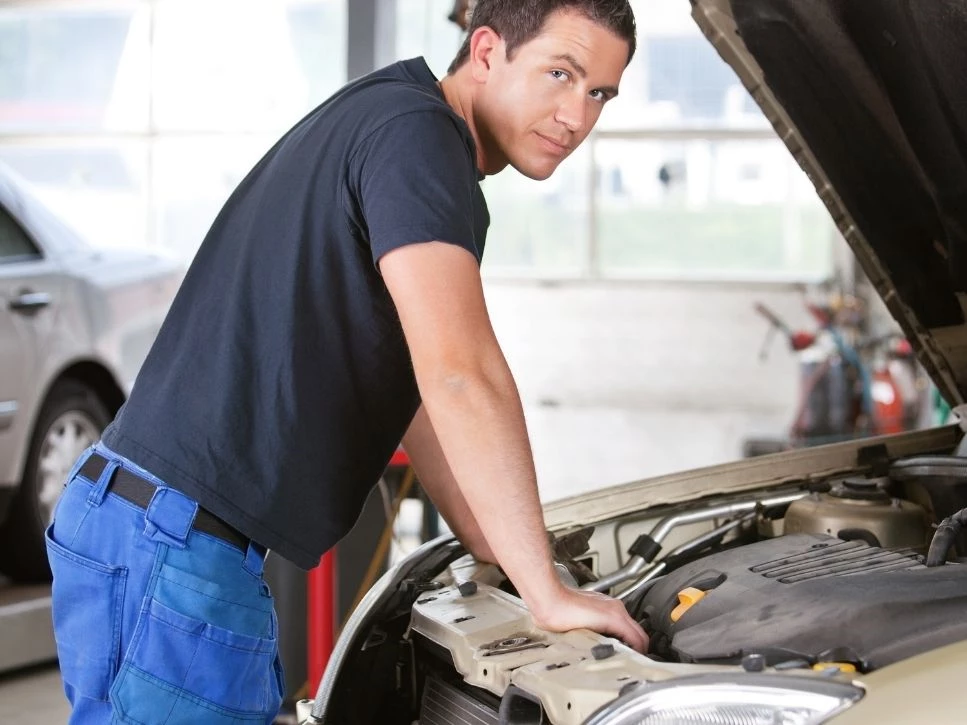
Is Bypassing the Crank Position Sensor Possible? Here's How
A guide to wiring 1, 2, 3, 4 wire oxygen sensors. detailed diagrams.
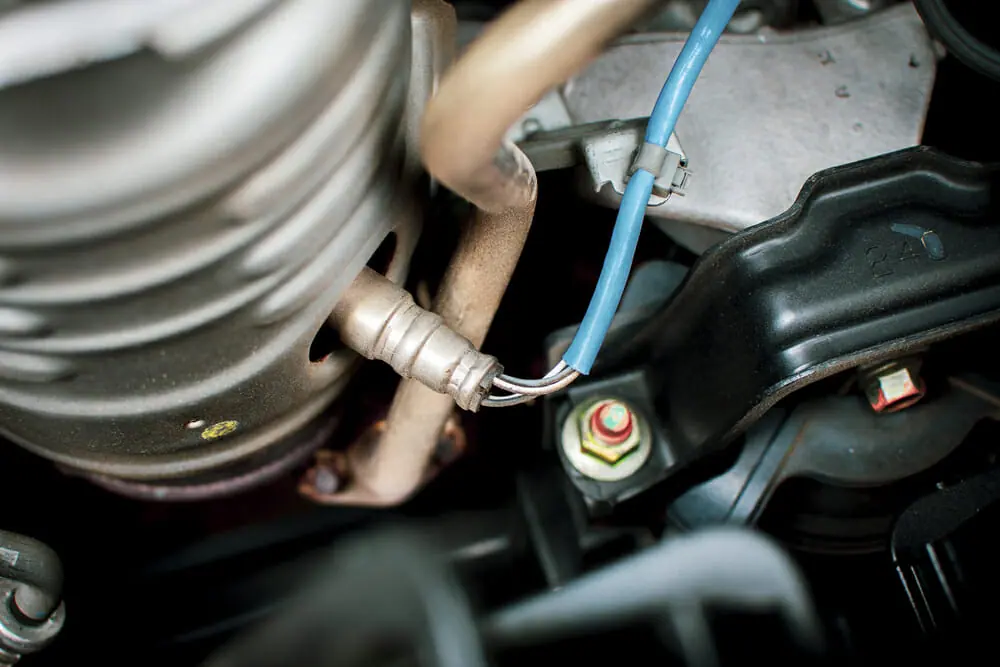
Mastering ASE Testing - The Ultimate Guide for Success

Keeping Current - Charging System Diagnosis and Repair
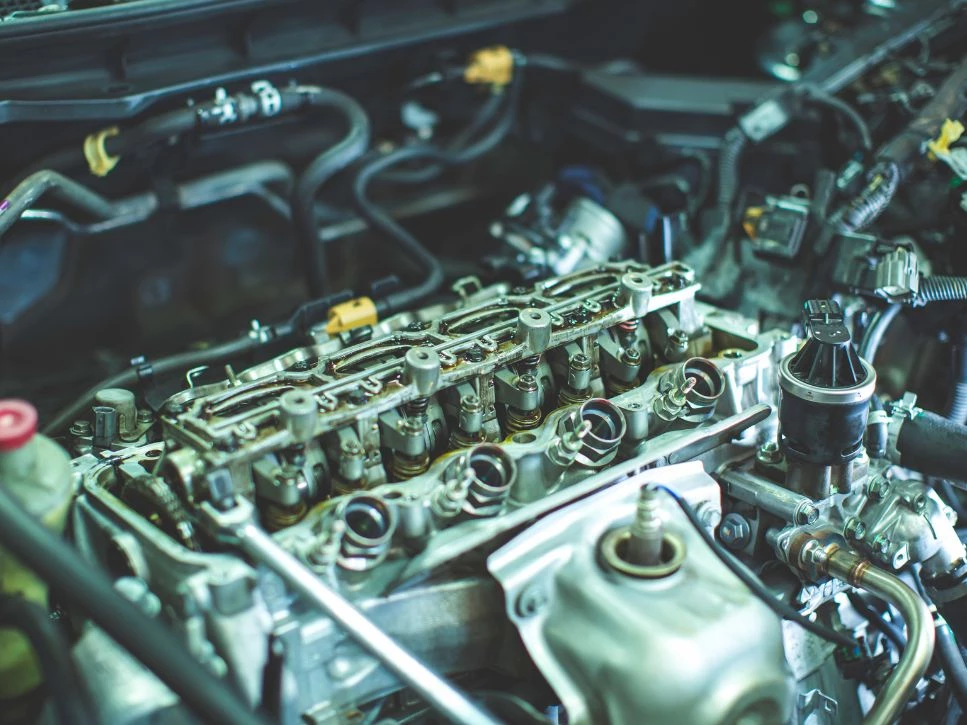
The complete ASE practice test with answers and explanations
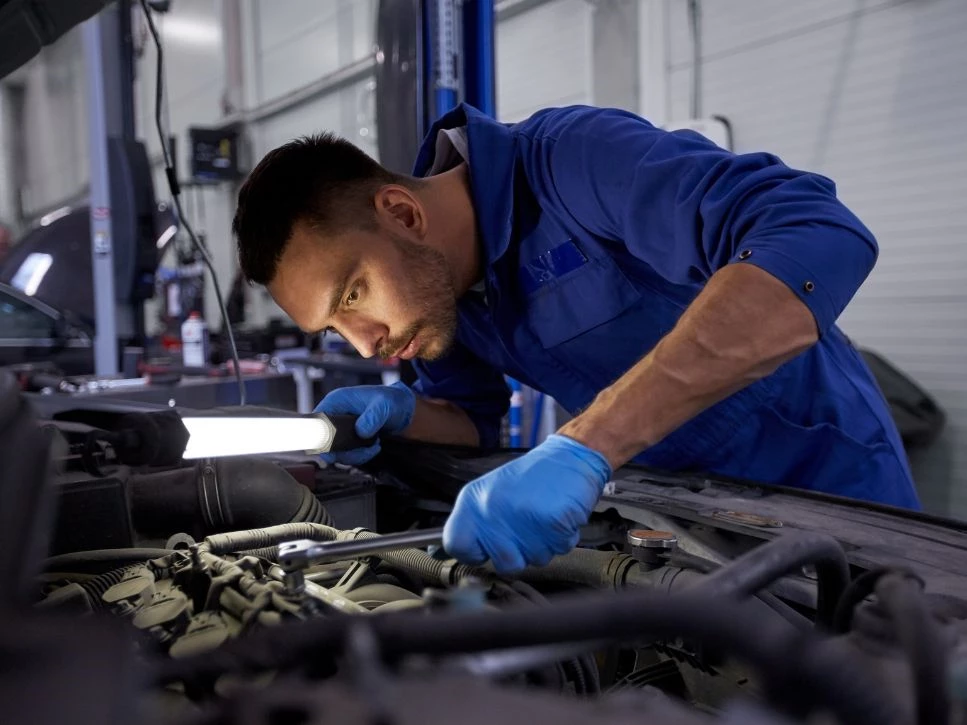
Enhancing the Ride - Accessories Diagnosis and Repair

- SourcePWR PLUS ® Power Supply
- Universal and Custom Cruise Control
- Vehicle Speed Limiters
- Hands-Free Bluetooth ® Systems
- Vehicle Camera Systems
- Digital Video Recording Systems
- Parking Assistance and Blind Spot Detection
- Vehicle Seating Upgrades
Find and order a Rostra camera system with our all-new Vision Cross-Reference Tool by clicking here .
- Don't see your vehicle listed here?
- Please send us a message by clicking here and we'll be happy to assist.
Vehicle Search
- Add-On Cruise Control Systems
Universal Cruise Control System by Rostra
Set your speed at the touch of a button! Once selected, a Global Cruise ® cruise control system constantly measures changes in engine loading and vehicle speed in order to maintain a set speed on the highway. Easily set the controls and avoid unintended speeding. To slow down or accelerate, you don't even have to touch the pedal. While column-mounted stalk-style control switches are available, dashboard surface-mount control switches provide the same functionality wherever it's most convenient!
Multiple control switch options!
Rostra's cruise control switches have been designed with the highest level of quality and have been tested and validated for use with the 250-1223 universal cruise control system. Please note that we do not recommend using any other brand of cruise control switch with a Rostra Global Cruise system as doing so may result in unintended cruise control operation, and invalidates any warranty provided with your cruise control system.
Rostra Cruise Controls are manufactured in the U.S.A. by the company that pioneered the development of cruise control technology.
Product Features
Designed to work with any vehicle incorporating the use of a mechanically-operated throttle, a Rostra Universal Cruise offers a great deal of flexibility when it comes to adding a cruise control system to your vehicle. Whether you're restoring a classic hot-rod, prepping the family minivan for holiday traveling or looking to save on the cost of fuel for your motorhome, a universal cruise control from Rostra is the only way to go!
- Improved Operation
- Coast/Reduce Speed
- Resume/ Accelerate
- Tap-Up, 1 MPH per tap
- Tap-Down, 1 MPH per tap
- Controlled Resume Rate
- Closer, More Accurate Control of Set Speed
- Enhanced Adaptability
- Works with 3, 4, 5, 6 or 8 Cylinders
- Select ECM, AC Generator, Magnets, or Pulse Sender as VSS *
- Select Square or Sine Wave Speed Signal Source
- Select Acceleration Rate
- Select Gain Control
- Select Manual or Automatic Transmission
- Select Open Circuit or Closed Circuit Engagement Switches
- Enhanced Features
- Modular Design
- Removable Wiring Harness with Locking Device
- Redesigned Water Sealing
- Neutral Safety Switch (NSS) Compatible
- Cruise Engaged Output (Ground Signal When Engaged)
- Self Diagnostic
- Easier Installation
- No Vacuum Required
- Smaller Module
- New Connectors with Positive Contact and Lock
- No Clutch Switch Needed (except Diesel)
- VSS (Vehicle Speed Sensor) Wire Already in Harness
- Compatible with Neutral Safety
- Compatible with Distributor-less Ignition Systems
- Compatible with Direct Fire Ignition Systems
* Rostra Global Cruise will not accept input from a tachometer to provide a vehicle speed signal.
Selecting Global Cruise Components for Installation
The Rostra Global Cruise universal cruise control system is designed to adapt to almost all automobiles that use a mechanically-operated throttle control system where an accelerator cable is present. Please use the Vehicle Search at the top of this page to find your specific vehicle listing, or use the guidelines below to select a cruise control system for your hot rod or street car custom vehicle build.
Step 1: Global Cruise Selection Part Number: 250-1223
Part number 250-1223 (photos below) includes the universal Global Cruise servo motor, throttle cable, universal mounting brackets, wiring harness and hardware package for making electrical and throttle control connections. The servo motor mounts in the vehicle's engine bay.
Step 2: Control Switch Selection Part Number: Various
At Rostra, we currently offer 15 different control switch options for engaging the Global Cruise system while driving. Click here to select a universal or specific control switch for your vehicle. Any cruise control switch from Rostra will adapt to the Global Cruise system.
Step 3: Providing Vehicle Speed Signal Part Number: Various
The Global Cruise system can adapt to pre-existing VSS input signals between 2,000 and 38,600 Pulses Per Mile (PPM). We also offer the 250-4165 magnetic VSS generator for speedometer cable-equipped vehicles, and the inline 250-4160 for early General Motors transmissions.
Step 4: Speed Signal Divider Part Number: Various
While many vehicles provide an electronic vehicle speed signal that the Global Cruise system can use to determine highway speed, in some instances this signal is out of range and needs to be reduced to be safely interpreted. In cases such as this, Rostra offers part numbers 250-4369 and 250-4379 to reduce the onboard VSS by 50% and 75%, respectively. Once the out-of-range signal has been reduced, the built-in programming switches on the cruise control servo can be dialed-in for the appropriate speed setting and smooth highway driving.
Step 5: Clutch Disengagement Switch Part Number: 250-4206 (M/T Only)
Modern vehicles that are equipped with a manual transmission generally include a clutch disengagement switch to provide a neutral safety signal to the vehicle's onboard computer, or provide a usable tachometer signal to detect excessive engine revs. Installation forms 4428 and 4429 can help determine if these signals are presently available on your vehicle. The Global Cruise system can adapt to these devices to disengage itself when the clutch pedal is depressed, or Rostra's 250-4206 can be installed to provide this important safety feature when no NSS information is available.
Step 6: Brake Pedal Signals Part Number: 250-4382
While the included primary wiring harness of the Global Cruise system includes wire leads meant to be attached to both the 'hot' and 'cold' sides of the brake pedal sensor to disengage the cruise control when the brake pedal is depressed, the proper ground signal is no longer present when a vehicle has been outfitted with LED lighting accessories such as LED brake lights. In a case like this, a 5-prong automotive relay must be used to provide the ground signal to cancel the cruise control once engaged. This relay and component wiring harness are available as part number 250-4382 .
Step 7: Purchasing a Global Cruise System
Global Cruise universal cruise control systems and associated adapters are sold through authorized product distributors throughout The United States and Canada, as well as through select international distributors in countries around the world. For purchasing information, or to locate a local retailer or installation facility, please contact us online or call our customer service department by dialing (800) 782-3379, Monday - Friday, 8:00 AM to 5:00 PM EST. To learn more about Rostra and our cruise control manufacturing facilities located in Orlando, FL, please click here .
Global Cruise Photos and Installation Instructions
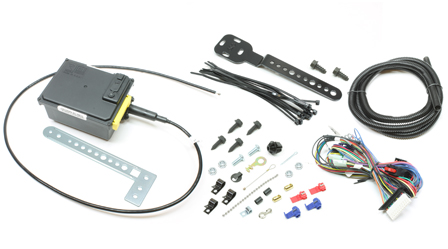
Click image to enlarge...
Installation Manuals

Universal Aftermarket Cruise Control Service Parts
Global Cruise Hardware
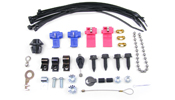
Cruise Control Module
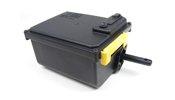
Cruise Harness Assembly
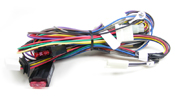
43" Cruise Cable Assembly
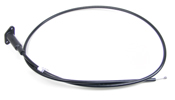
Cable Bracket Assembly
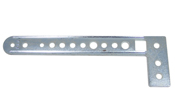
Global Cruise Accessories and Service Parts
Replacement Magnets, 10-pack
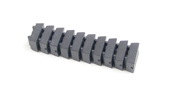
Magnet Package with Tie Strap
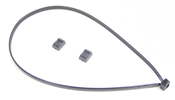
Replacement Clutch Switch
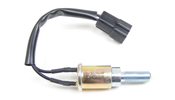
Reservoir (No longer available)
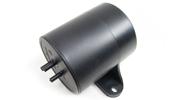
Speed Signal Generator
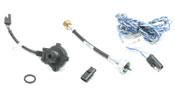
Form #59A-02361G
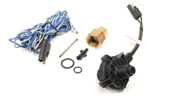
T-Bar Adaptor
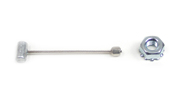
Clutch Disengagement Switch
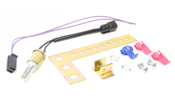
VSS Divider (Divide By 2)
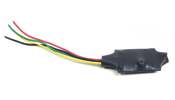
VSS Divider (Divide By 4)
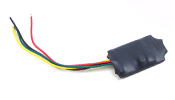
Relay Package
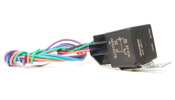
Frequently Asked Questions
Global cruise application.
Q: Can I install Rostra's Global Cruise system on a motorcycle or ATV?
A: At Rostra, we love seeing the inventive ways in which our customers apply products that we manufacture to a variety applications. But, while a number of online forums exist that detail the multitude of installation options for our products on non-passenger vehicle modes of transportation, due to safety concerns surrounding these installations, we do not actively support these applications. Our technical support is provided through extensive real-world testing that at this time does not include working with said vehicles.
Q: When installing Rostra's Global Cruise system, can I mount the cruise control servo motor to the vehicle's engine?
A: When selecting a mounting location for your Global Cruise servo motor, it is best to take into consideration the deteriorating effects heat and vibration have on all vehicle electronics. Because of the amount of heat generated by a vehicle's engine and exhaust manifolds, we recommend mounting the Global Cruise servo motor as far from these two as possible as heat and vibration damage to the motor can result in our standard 3-year/36,000 mile warranty being voided. For a list of places that we do not recommend, please see below:
- Underneath the vehicle's fender exposed to the elements
- Underneath the vehicle itself exposed to road debris
- Directly to the vehicle's engine with heat and vibration
- In any location with the cable points towards the ground
- Near sharp, hot, or moving objects (pulleys, CV shafts, etc...)
- Near the vehicle's ignition coil (no closer than 10" (255mm)
- Within the passenger compartment (see Q/A below)
- Where it will interfere with vehicle maintenance/service checks.
Q: Can I permanently mount Rostra's Global Cruise servo motor on the inside of my vehicle?
A: The short answer - Yes, this is a possibility. While mounting the Global Cruise servo motor within the passenger cabin is certainly an option, installers are warned that the motor itself makes a fair amount of noise as it pulls the vehicle's throttle back and forth to maintain highway speeds. While hot rod owners may never notice the sound of the motor, more modern vehicles that include ample sound dampening from road noise likely will.
Q: The throttle cable attached to Rostra's Global Cruise servo motor is too long for my application. Can I cut it?
A: No. Cutting the throttle cable attached to the Global Cruise servo motor due to its length is highly inadvisable as it can directly impact the throttle cable's ability to move freely into and out of the servo motor. Instead, the servo motor can be mounted in such a way that the cable can be looped to create a shorter distance. Please note that this loop must have greater than a 6-inch diameter.
Q: Do I need to connect the Dark Blue Tachometer (TACH) or Light Green Neutral Safety (NSS) wires from the Global Cruise system's main wiring harness for cruise control operation?
A: While neither the Tachometer Signal wire (for manual transmission vehicles) or Neutral Safety wire (for automatic transmission vehicles) need to be connected for cruise control operation, we highly advise that they are as they provide over-rev protection by disengaging the cruise control system in situations where the engine could be accidentally "knocked" into neutral while driving (NSS/automatic transmission), or when the clutch pedal is depressed (TACH/manual transmission).
Global Cruise Accessories
Q: My vehicle is not equipped with an electronic vehicle speed sensor (VSS). Can I still install Rostra's Global Cruise system?
A: Absolutely! The Global Cruise provides an incredibly dynamic way of controlling speed on vehicles equipped with a mechanically-operated throttle - whether or not they include a pre-existing and/or usable VSS. For vehicles that fall into this category, we manufacture a number of speed signal generators that tell our cruise control how fast your vehicle is moving so that it can effectively hold the speed for you. For Chrysler/Mopar and Chevrolet vehicles manufactured anywhere from the early 1950's to late 1980's (when electronic VSS became standard), we offer part number 250-4160 - a device that is installed between the transmission and speedometer cable to generate a usable speed signal. For vehicles where underbody space is an issue and the transmission rests closely to a crossmember or the vehicle's body, we also offer the same equipment with a speedometer cable extension as part number 250-4153 . For Ford and all other vehicle makes, we offer part number 250-4165 - a sensor that attaches to the vehicle's body and a package of magnets that attach to the vehicle's driveshaft or CV shaft. When the shaft spins and the magnet(s) pass by the sensor, a speed signal is generated.
Rostra cruise control systems are only validated on vehicles available in the United States and Canada.
For the best in driving experience, choose a cruise control from Rostra, the leader in cruise control technology. Contact us today for purchasing information.
Rostra is a leading manufacturer of automotive comfort, safety, and convenience accessories including electronic cruise control systems, vehicle speed limiters, backup camera relocation kits, LED lighting, exterior vehicle camera systems, automotive lumbar supports and seat heaters, driver alert systems, and more.
Rostra: 2351 J. Lawson Blvd. Orlando, FL, 32824
WHAT OUR CUSTOMERS SAY
" Just what I needed for my 1962 Thunderbird! Before installing this, I would get leg cramps holding the throttle constant while cruising, I swear the throttle return spring was originally a bed spring. Installed this beauty before taking my trip down RT 66 in 2015. Finally, 7500 miles in comfort! "
Jim H. - United States
250-1223 Universal Electronic Cruise Control
" This is great. It installed pretty easily. I put it on my F-350 so I can park easier since my front camera is obstructed my LED lights and a light bar. I easily installed the sensors in the air dam below the bumper. "
Schawn D. - United States
Forward-Facing Parking Sensor System
" This installed very easily. I highly recommend it for anyone who needs this feature to make their car seat more comfortable. But this does require a high level of car handy skills, as you need to significantly disassemble a car seat. "
Sam G. - United States
Universal Lumbar Support System
" I installed this in a 2018 RZR RS one. I ride in the winter and have only a windshield. I installed the seat heater and it keeps me very warm. "
Ron B. - United States
Universal Seat Heater
" Once installed, the Jeep is more noticeable as one would expect. This is a very good safety upgrade--I was surprised DRL's were not standard on Wranglers. I have had compliments from other Wrangler owners. "
Chessie T. - United States
Jeep Wrangler LED Fender DRL
Be the first to know about special promotions and product updates. Enter your email and subscribe to our newsletter.
© 2024 Rostra Accessories
- Vision Cross-Reference
- Privacy Policy
- About Rostra
- The Best Things To See...
The Best Things to Do in Nizhny Novgorod

Nizhny Novgorod, founded in 1221, is one of the oldest cities in Russia, so is home to an array of historic attractions. If you’re headed to the 2018 FIFA World Cup in Russia and happen to find yourself in Nizhny Novgorod, it would be an absolute shame to miss out on seeing the city. Here are the best things to see and do.
Go back in time on bolshaya pokrovskaya.
If you’re a fan of the Golden Age of Russian literature, Bolshaya Pokrovskaya is the place for you to go. As one of the city’s central streets, long lines of well-preserved 19th-century buildings stretch along both sides. It’s not only the architecture that will transport you back in time: sculptures of past inhabitants of the town, each with a story to tell, will make you feel as if you were a character in a Dostoevsky novel.
Bolshaya Pokorovskaya, Nizhny Novgorod, Russia

The Chkalov Staircase, consisting of almost 600 stairs, leads from the Kremlin to the riverbank. On a sunny day, after a long walk around the Kremlin, head down to the Volga river, stroll along it and have lunch sitting on one of the benches placed near the boardwalk.
Chkalov Stairs, Kreml, Nizhny Novgorod, Russia

See the river from above
A cable car runs above the river from Nizhny Novgorod to Bor, a town on the other side of the Volga river. It is often used by locals as a means of public transport and the views from it are breathtaking. Spend an afternoon going to Bor and back; a trip that is most certainly worth your time.
Nizny Novgorod Cable Car, Kazanskaya Naberezhnaya 8, Nizhny Novgorod, Russia

Spend an afternoon in space
In a district just outside the city centre you’ll find a very special monument dedicated to Gromozeka, a well-loved character from a sci-fi Soviet cartoon. Gromozeka, whose metal sculpture can now be found on the playground in Nizhny Novgorod, was a friendly alien archaeologist from a far-away planet called Chumaroz. A few benches around the monument are hidden in what look like USSR space helmets. A must-see for all the space geeks out there.
Gromozeka monument, Tropina, Nizhny Novgorod, Russia
1. Visit the Nizhny Novgorod Kremlin

2. Get a sneak-peek into Nizhny Novgorod's pre-revolutionary literary world
Building, Museum

3. Become a 19th-century nobleman or woman for the day

Looking for things to do in Moscow? Check out our guide here .
Since you are here, we would like to share our vision for the future of travel - and the direction Culture Trip is moving in.
Culture Trip launched in 2011 with a simple yet passionate mission: to inspire people to go beyond their boundaries and experience what makes a place, its people and its culture special and meaningful — and this is still in our DNA today. We are proud that, for more than a decade, millions like you have trusted our award-winning recommendations by people who deeply understand what makes certain places and communities so special.
Increasingly we believe the world needs more meaningful, real-life connections between curious travellers keen to explore the world in a more responsible way. That is why we have intensively curated a collection of premium small-group trips as an invitation to meet and connect with new, like-minded people for once-in-a-lifetime experiences in three categories: Culture Trips, Rail Trips and Private Trips. Our Trips are suitable for both solo travelers, couples and friends who want to explore the world together.
Culture Trips are deeply immersive 5 to 16 days itineraries, that combine authentic local experiences, exciting activities and 4-5* accommodation to look forward to at the end of each day. Our Rail Trips are our most planet-friendly itineraries that invite you to take the scenic route, relax whilst getting under the skin of a destination. Our Private Trips are fully tailored itineraries, curated by our Travel Experts specifically for you, your friends or your family.
We know that many of you worry about the environmental impact of travel and are looking for ways of expanding horizons in ways that do minimal harm - and may even bring benefits. We are committed to go as far as possible in curating our trips with care for the planet. That is why all of our trips are flightless in destination, fully carbon offset - and we have ambitious plans to be net zero in the very near future.

Restaurants
The best halal restaurants in kaliningrad.

The Mystery Behind Russia's Buddhist "Miracle"

Incredible Photos From the Longest Bike Race in the World

Food & Drink
The best halal restaurants in kazan.

Zhenotdel: The Soviet Union's Feminist Movement

A Soviet Pilot Went Missing in Afghanistan and Was Found 30 Years Later

A Guide to Cautionary Russian Proverbs and What They Mean

Guides & Tips
A 48 hour guide to astrakhan, russia.

See & Do
Russia's most remote holiday destinations.

Unusual Facts About the Soviet Union

Russian Last Names and Their Meanings

The Soviet Union’s Best Heart-Throbs and Pinups
Culture trip spring sale, save up to $1,100 on our unique small-group trips limited spots..

- Post ID: 1584120
- Sponsored? No
- View Payload

- Nizhny Novgorod
Nizhny Novgorod, Russia
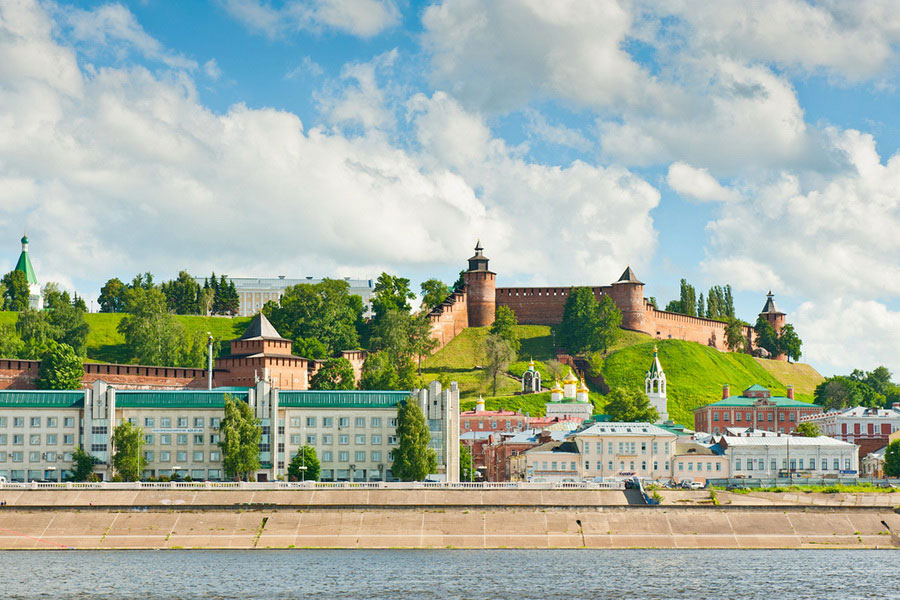
Tours, Attractions and Things To Do in Nizhny Novgorod
Nizhny Novgorod is the fifth largest city in Russia with a population exceeding 1.2 million. The city is located at the confluence of two rivers - the Volga and Oka. It is the center of Nizhny Novgorod region and Volga Federal District, as well as one of the country’s major administrative, economic and cultural centers.
Furthermore, Nizhny Novgorod is the Russia’s largest industrial center with the enterprises of mechanical engineering, metalworking information technology playing a leading role.
Nizhny Novgorod was founded in 1221 by Prince Yuri Vsevolodovich to protect Russian borders. Under Ivan III, Nizhny Novgorod was a sentry city. It had a regular army. This was the place for Moscow to march against Kazan.
Nizhny Novgorod made a great contribution to the construction of the Russian state. In 1612, Kuz’ma Minin and Prince Dmistry Pozharsky’s militia from Nizhny Novgorod played a decisive role in the liberation of Moscow from Polish intervention.
During the Soviet period from 1932 to 1990, the city was named after Maxim Gorky, the Great Russian writer who was born there. From 1959 to 1991 it was a “forbidden” city for foreigners because of defense plants, located there. On October 22, 1990 the city got its former name, and about at the same time, it began developping tourist business.
Today, the city, once playing such a significant role in the history of Russia, is developed into a modern metropolis. So, the urban development plan intends to build a metro bridge, cableway, funicular, and a new branched transport infrastructure there. Furthermore, Nizhny Novgorod is the Russia’s largest center of river cruise tourism and venue of Nizhny Novgorod fair-based major international exhibitions.
Nizhny Novgorod is one of the richest cultural centers of Russia. The most prominent artists have received education in the local theater and art schools. The city has opened a large number of theaters, museums and cinemas.
This city can surprise any traveler by an entwinement of modern and ancient buildings, each time rising before your eyes in a completely unexpected appearance.
Attractions
Miscellaneous.

- Visit Our Blog about Russia to know more about Russian sights, history
- Check out our Russian cities and regions guides
- Follow us on Twitter and Facebook to better understand Russia
- Info about getting Russian visa , the main airports , how to rent an apartment
- Our Expert answers your questions about Russia, some tips about sending flowers

Russian regions
- Bashkortostan republic
- Chuvashia republic
- Kirov oblast
- Mari El republic
- Mordovia republic
- Nizhegorodskaya oblast
- Orenburg oblast
- Penza oblast
- Samara oblast
- Saratov oblast
- Tatarstan republic
- Udmurt republic
- Ulyanovsk oblast
- Map of Russia
- All cities and regions
- Blog about Russia
- News from Russia
- How to get a visa
- Flights to Russia
- Russian hotels
- Renting apartments
- Russian currency
- FIFA World Cup 2018
- Submit an article
- Flowers to Russia
- Ask our Expert
Nizhny Novgorod city, Russia
The capital city of Nizhegorodskaya oblast .
Nizhny Novgorod - Overview
Nizhny Novgorod (colloquially often just “Nizhny”; from 1932 to 1990 - Gorky) is a large city located in the center of European Russia, the administrative center of the Volga Federal District and Nizhny Novgorod Oblast.
It is an important economic, industrial, scientific, educational, and cultural center of Russia, the largest transport hub of the Volga Federal District. Nizhny Novgorod is one of the main centers of river tourism in Russia. The historic part of the city is rich in sights and is a popular tourist destination.
The population of Nizhny Novgorod is about 1,234,000 (2022), the area - 411 sq. km.
The phone code - +7 831, the postal codes - 603000-603257.
Nizhny Novgorod city flag
Nizhny novgorod city coat of arms.
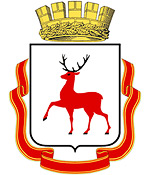
Nizhny Novgorod city map, Russia
Nizhny novgorod city latest news and posts from our blog:.
7 January, 2022 / Nikolai Bugrov's Summer Dacha in Volodarsk .
4 December, 2017 / Stadiums and Matches of the World Cup 2018 in Russia .
2 June, 2017 / The Most Beautiful House in Nizhny Novgorod .
13 March, 2016 / Official Look of Host Cities of World Cup 2018 in Russia .
29 September, 2015 / Nizhny Novgorod - the view from above .
More posts..
History of Nizhny Novgorod
Foundation of nizhny novgorod.
During the military campaigns of the Russian princes against the Volga Bulgaria, the place where the Oka River flows into the Volga was used as a gathering point for the Murom and Suzdal troops. In 1220, Grand Duke Yuri Vsevolodovich (the grandson of Prince Yuri Dolgoruky, the founder of Moscow) conducted a successful campaign against the Bulgars. After it, he “decided to strengthen this important place for Rus” and founded a town at the mouth of the Oka.
It was named Novgorod, which literally means “new town”. Later, the adjective “nizhny” (“lower”) was added to the name of the town in the Russian annals. This was probably done in order to distinguish it from the town of Novgorod (present Veliky Novgorod) and other Novgorods that existed at that time.
The founding of Nizhny Novgorod was the beginning of an active expansion of Russian influence in the Mordovian lands. Two white-stone churches were built in the fortress, including the Cathedral of the Archangel (1227) - evidence of the special role that the town had in the system of lands of Vladimir-Suzdal Rus. However, the Mongol invasion stopped further development.
Information about Nizhny Novgorod of the 13th century is extremely scarce. But it is known that after the invasion it revived relatively quickly. Nizhny Novgorod is constantly mentioned in Russian chronicles as a major political and economic center of North-Eastern Rus and a spiritual center of Orthodoxy in the Volga region. The town was often the object of conflicts between Moscow and Tver.
In 1392, the Moscow prince Vasily I received a jarlig for the Nizhny Novgorod Principality and captured Nizhny Novgorod. The final annexation of Nizhny Novgorod to the possessions of Moscow took place in the late 1440s.
More Historical Facts…
Nizhny Novgorod in the 16th-18th centuries
Under Ivan III and Vasily III, the town played the role of a border post and was a gathering place for military campaigns against the Kazan Khanate. In 1508-1515, the stone kremlin was built. After the capture of Kazan by Ivan the Terrible, the border role of Nizhny Novgorod became insignificant. At the same time, Nizhny Novgorod became the center of trade between Russia and the East and a large shipbuilding center.
In September 1611, during the Time of Troubles, the Second People’s Militia was organized in Nizhny Novgorod to fight the Poles who were able to establish control over Moscow. The militia consisted of detachments of townspeople, peasants of the central and northern regions of the Tsardom of Russia. The leaders were the Nizhny Novgorod merchant Kuzma Minin and Prince Dmitry Pozharsky (the monument to them is installed on Red Square in Moscow). In October 1612, the militia was able to completely liberate Moscow.
In the 17th century, a schism occurred in the Orthodox Church under Patriarch Nikon. It led to the formation of numerous settlements of Old Believers in the vicinity of Nizhny Novgorod. In 1695, during his Azov campaign, Peter I arrived in Nizhny Novgorod. In 1719, as a result of his administrative-territorial reforms, the town became the center of a separate Nizhny Novgorod Governorate. In 1722, setting off on the Persian campaign, Nizhny Novgorod was again visited by Peter I. Here he celebrated his 50th birthday.
In 1767, Nizhny Novgorod was visited by Empress Catherine II. During her stay in the town, she met the famous local mechanic and inventor Ivan Kulibin. After her visit, a new regular town plan was approved. The first town theater was built in 1798. Later, it became known as Nikolaevsky, in honor of Emperor Nicholas I.
Nizhny Novgorod in the 19th century
At the turn of the 18th and 19th centuries, Nizhny Novgorod became a major scientific and cultural center of the Russian Empire. In 1811, the population of Nizhny Novgorod was about 14,400 people. In 1817, the Makaryev Fair, the largest fair of the Russian Empire, was moved to the village of Kunavino (one of the districts of today’s Nizhny Novgorod). Before that, it was organized every year near the Makaryevsky Monastery, which burned down a year earlier. From that time on, it began to be called the Nizhny Novgorod Fair. Thanks to it, the rapid economic development of the town and adjacent villages began.
After Emperor Nicholas I visited the town in 1834, the large-scale reconstruction of Nizhny Novgorod began. In 1847, a water supply system appeared in the town and the first fountain was built. Private buildings in the Nizhny Novgorod Kremlin were demolished and new administrative buildings appeared in their place. A lot of new buildings, streets, boulevards, and gardens were built.
In 1849, a large industrial enterprise was founded in the village of Sormovo (another district of today’s Nizhny Novgorod). Later, it became known as the Sormovo plant. It was producing river steamers, various railway cars, steam locomotives, and trams. Thanks to the plant, Sormovo soon turned into a large village of workers. In 1862, the construction of the Moscow-Nizhny Novgorod railway was completed. In 1863, the population of the city was 41,500 people.
In 1896, the city hosted the All-Russian Trade and Industrial Exhibition. The radio receiver of the engineer A.S. Popov, the hyperboloid tower of the engineer V.G. Shukhov were demonstrated at the exhibition, as well as the first Russian car of the Frese and Yakovlev factories.
Nizhny Novgorod in the first half of the 20th century
In 1914, about 111,000 people lived in Nizhny Novgorod. In 1917, during the First World War, the Warsaw Polytechnic Institute was evacuated to this city, on the basis of which the Nizhny Novgorod Polytechnic Institute was created.
On October 7, 1932, Nizhny Novgorod was renamed Gorky due to the 40th anniversary of the literary and social activities of the writer Maxim Gorky. In 1933, the first permanent bridge across the Oka River was built. The railway bridge across the Volga was constructed too. Thanks to this, it became possible to go by rail through Gorky to the Urals and Siberia.
The 1930s were a period of rapid industrialization. In 1932, the largest industrial enterprise in the city was opened - the Gorky Automobile Plant (GAZ), an important object of the Soviet defense industry. In the 1930s-1940s, the city was even referred to as “Russian Detroit”. By 1939, the population of Nizhny Novgorod increased to about 644,000 people.
Every fourth resident of the Gorky region (about 822 thousand people) fought on the fronts of the Second World War. Of these, more than 350 thousand people did not return from the battlefields - they were killed, went missing or died from wounds in hospitals.
In June 1943, three large raids of German bombers were carried out on Gorky. The main target of air strikes was the Gorky Automobile Plant, which as a result was almost completely destroyed. It was rebuilt only in the middle of 1944. Over 500,000 wounded were treated in dozens of hospitals during the war years.
The city was an important center for the production of weapons. During the Second World War, every second Soviet car, every third tank and every fourth artillery piece were produced at Gorky’s plants. In total, about 38 thousand tanks, self-propelled guns, armored vehicles, 43 thousand mortars, 16 thousand aircraft, 22 submarines, 109 thousand cars, more than 85 thousand radio stations, as well as 101 thousand artillery pieces and 1,165 Katyusha multiple rocket launchers were produced in Gorky.
Nizhny Novgorod after the Second World War
In 1946, the first GAZ-M-20 “Pobeda” passenger car and the GAZ-51 truck left the assembly line of the Gorky Automobile Plant. In 1949, the construction of the monumental Chkalov Stairs connecting the Upper Volga and Lower Volga embankments was completed in the historic center of Nizhny Novgorod. On August 4, 1959, the resolution of the Council of Ministers of the USSR “On the closure of the city of Gorky for visiting by foreigners” was issued. In 1962, the population of Gorky exceeded 1 million people.
On January 18, 1970, a radiation accident occurred at the Krasnoe Sormovo plant. During the construction of a nuclear submarine, an unauthorized launch of the reactor took place. After working at prohibitive power for about 10-15 seconds, it partially collapsed. Hundreds of workers were exposed to the radioactive release. In total, over one thousand people took part in the liquidation of the consequences of the accident and were exposed to radiation.
In 1985, a subway was opened in Gorky. In 1980-1986, Andrei Sakharov, a world famous nuclear physicist, Nobel laureate, and activist, was in exile in Gorky to prevent his contacts with foreigners. In the early 1990s, the “closed city” status was lifted and the city became accessible to foreigners. On October 22, 1990, Gorky was renamed back to Nizhny Novgorod. In 1991, the population of the city reached its maximum - 1,445,000 people.
At the end of the 20th century, the information technology sphere began to actively develop in the city. In the 2000s, a transport problem arose because of the insufficient carrying capacity of the Nizhny Novgorod bridges connecting the lower part of the city and the upper one.
In February 2012, the Nizhny Novgorod Volga Aerial Tramway was opened. This 3661-meter-long gondola lift cable car connected Nizhny Novgorod with the town of Bor. Its daily passenger traffic is about 5,000 people. In 2013, the city electric train was launched - an alternative to the subway line from Sormovo to Moskovsky railway station.
Nizhny Novgorod hosted 6 matches of the FIFA World Cup 2018 . A new stadium was built, the old river port was demolished, a new park and embankments were created. Large-scale restoration of old streets and buildings took place, new museums were opened, hotels were built, and parks were reconstructed.
Streets of Nizhny Novgorod
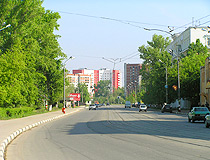
One sunny summer day in Nizhniy Novgorod
Author: Denis Plekhanov
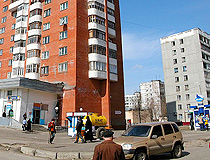
Apartment buildings in Nizhny Novgorod
Author: Eugene Ivanov
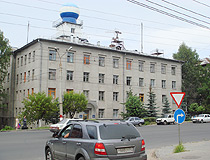
On the street in Nizhny Novgorod
Author: Sergey S. Kazenyuk
Nizhny Novgorod - Features
Nizhny Novgorod is located about 425 km east of Moscow, at the confluence of the two largest waterways of the European part of Russia - the Volga and Oka rivers. The city is divided by the Oka into two parts. The length of Nizhny Novgorod along the Oka is 20 km, along the Volga - about 30 km.
The climate in Nizhny Novgorod is moderately continental, with cold, long winters and warm, relatively short summers. The average temperature in January is minus 8.9 degrees Celsius, in July - plus 19.4 degrees Celsius.
A red deer is depicted on the coat of arms and flag of Nizhny Novgorod, which is a symbol of nobility, purity, life, wisdom, and justice. The City Day is celebrated on the 3rd Saturday in August.
In January 2019, Nizhny Novgorod was recognized as the best city in Russia in terms of quality of life. It took first place among Russian cities and 109th in the world in terms of quality of life. The rating was compiled by the site numbeo.com, which specializes in statistics on the cost of living and consumer prices in different countries of the world.
When compiling the rating, the purchasing power of the population, safety, health care, the cost of living, the ratio of real estate prices to the population’s income, traffic congestion, the level of environmental pollution, and climate were taken into account.
The main branches of the local industry are the production of cars and weapons, shipbuilding. Nizhny Novgorod is also one of the IT centers of Russia.
Nizhny Novgorod is a major transport hub. The city has a railway station, a river station, a cargo port, several berths for transshipment of goods. Strigino International Airport named after V.P. Chkalov offers regular flights to such cities as Yekaterinburg, Kazan, Kaliningrad, Moscow, Novosibirsk, Samara, St. Petersburg, Sochi, and a number of others.
Public transport in Nizhny Novgorod plays a very important role in ensuring the life of the city. At the same time, its work is hampered by the distribution of its population on the city’s territory, large daily migrations, a very high concentration of passenger traffic on the bridges across the Oka River, and the lack of an all-encompassing system of high-speed transport. There are municipal buses, fixed-route minibuses, trams, trolleybuses, the city train, and subway.
The tourist potential of Nizhny Novgorod is quite high. According to UNESCO, it is one of the most valuable historical cities in the world. In total, there are more than 600 unique historical, architectural and cultural monuments in Nizhny Novgorod, a variety of museums. The best time to visit Nizhny Novgorod is summer.
One of the alternative ways to visit Nizhny Novgorod is to take a river cruise along the Volga River. Travelers will find exciting excursions and meals in traditional Russian taverns. It will also be interesting to come during one of the many fairs or ethnographic festivals that are held in the city.
Main Attractions of Nizhny Novgorod
Nizhny Novgorod Kremlin (1508-1515) - a fortress in the historic center of Nizhny Novgorod and its oldest part, the main architectural complex of the city located on the right high bank, at the confluence of the Volga and Oka rivers. To date, all 13 towers of the Nizhny Novgorod Kremlin have been preserved or have been restored. The thickness of the wall at the base reaches 5 meters. There are exhibitions in the towers of the fortress; a section of the wall is open for tourists to visit.
In the past, there were several churches on the territory of the Nizhny Novgorod Kremlin. Today, only the Archangel Michael Cathedral has survived, built no later than the middle of the 16th century and rebuilt in 1628-1631 - the oldest surviving building in the kremlin. There is the grave of Kuzma Minin inside it.
An excellent view of the Volga River and Strelka (the confluence of the Oka and Volga) opens from the walls of the Nizhny Novgorod Kremlin. Here you can also see a collection of military equipment from the Second World War.
Nizhny Novgorod State Art Museum - one of the oldest museums in Russia, the largest museum of fine arts in the Nizhny Novgorod region. The Governor’s Palace on the territory of the Nizhny Novgorod Kremlin houses a permanent exhibition of Russian art and a collection of artistic silver.
In the House of the Merchant and Benefactor D.V. Sirotkin (Verkhnevolzhskaya Embankment, 3), an exposition of Western European art is presented and, separately, the painting by K.E. Makovsky “The appeal of Kuzma Minin to the citizens of Nizhny Novgorod” - one of the largest paintings on a historical theme in Russia (698x594 cm).
Chkalov Stairs (1943-1949) - a monumental staircase in the form of a figure eight in the historic center of Nizhny Novgorod. Connecting the Upper Volga (Verkhnevolzhskaya) and Lower Volga (Nizhnevolzhskaya) embankments, it is one of the longest stairs in Russia. It starts from the observation deck at the monument to Valery Chkalov (the famous Soviet pilot who made the first non-stop flight from the USSR to the USA via the North Pole), next to the St. George Tower of the Nizhny Novgorod Kremlin.
Bolshaya Pokrovskaya Street - the main street of Nizhny Novgorod built up with noble mansions of the past centuries. A large part of Bolshaya Pokrovskaya is reserved for the pedestrian zone and is analogous to the pedestrian Arbat Street in Moscow. There are a lot of historic houses, cafes, souvenir shops, boutiques, monuments, and sculptures here. The length of the street is over 2 km.
The building of the State Bank (Bolshaya Pokrovskaya Street, 26), resembling a medieval palace, is an outstanding architectural monument built in the Russian Revival style in 1911-1913. In the Museum of Old Equipment and Tools (Bolshaya Pokrovskaya Street, 43), you can see unique exhibits, hear their history, and even touch them.
Fedorovsky Embankment - one of the most beautiful embankments in Nizhny Novgorod and the best observation deck in the city. Everything is perfectly visible from this embankment: the old part of the city, the river station with a park, the Kanavinsky bridge - one of the oldest in the city, and, of course, the opposite bank of the Oka River with the Alexander Nevsky Cathedral, the confluence of the Oka and Volga. People also come here to watch the sunset.
Nizhny Novgorod Volga Aerial Tramway . This cable car, 3661 meters long, connects the high right bank of the Volga River, where the historic part of Nizhny Novgorod is located, with the town of Bor. It has the largest unsupported span over the water surface in Europe - 861 meters.
A one way trip during which you can admire the picturesque views of Nizhny Novgorod and the Volga River takes 15 minutes. It is better to use it in good sunny weather, because in windy weather, the movement of the cabins can be stopped. Sennaya Square on Kazanskaya Embankment.
Nizhny Novgorod State Museum of History and Architecture (1875-1877). Also known as the Mansion of S.M. Rukavishnikov, it is an architectural ensemble built in the eclectic style in the historic center of Nizhny Novgorod, one of the most important and famous architectural monuments of this city. Guided tours are held in the premises, allowing you to learn about the life of the former owners of the mansion, as well as look at the historical expositions of different years. Verkhnevolzhskaya Embankment, 7.
Main Palace of Nizhny Novgorod Fair - a luxurious building constructed in the forms of Old Russian architecture of the 17th century. Today, exhibitions of various formats are held here, as well as the multimedia exposition “Russia - my history” dedicated mainly to the history of Nizhny Novgorod starting from the Finno-Ugric peoples. Sovnarkomovskaya Street, 13.
Museum of the History of the Gorky Automobile Plant . The museum houses expositions telling about the history and development of the Gorky Automobile Plant. In total, there are over 40,000 exhibits. Here you can see a collection of Soviet vintage cars, which includes “Chaika”, “Volga”, the truck “GAZ-51”, and a lot of others. Lenina Avenue, 95.
Alexander Nevsky Cathedral (1868-1881) - the most noticeable sight of the lower part of Nizhny Novgorod, which can be seen from all observation decks of the upper city. The church, 87 meters high, was built on the site of the Nizhny Novgorod Fair at the expense of merchants, who wanted to perpetuate the visit of Emperor Alexander II. Strelka Street, 3a.
Church of the Nativity of the Blessed Virgin Mary (1696-1719) - one of the best examples of the Stroganov Baroque, an architectural monument of federal significance. From a distance, this colorful building looks like a sugar gingerbread with “candy” domes and decorated with stone flowers, pears and apples. Rozhdestvenskaya Street, 34.
Pechersky Ascension Monastery - one of the most interesting places in Nizhny Novgorod, where you can feel the spirit of the city. Most of the monastery buildings date back to the first half of the 17th century. A lot of beautiful photographs can be taken here. Privolzhskaya Sloboda Street, 108.
Limpopo Zoo - the first private zoo in Russia. More than 270 species of animals live here, 25 of which are listed in the Red Book of the Russian Federation. It is located on the territory of the Sormovsky Park on an area of 7.1 hectares. Yaroshenko Street, 7b.
Architectural and Ethnographic Museum-Reserve “Shcholokovskiy Khutor” . The exposition of this museum is represented by 16 objects of rural architecture: residential houses, barns, mills and churches of the 17th-19th centuries brought from the northern districts of the Nizhny Novgorod region. The facades of the houses are decorated with traditional relief carvings. In the premises of the houses, interiors with authentic items of peasant life have been restored. Gorbatovskaya Street, 41.
Nizhny Novgorod city of Russia photos
Pictures of nizhny novgorod.
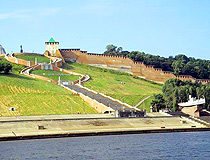
Chkalov Stairs and the Nizhny Novgorod Kremlin
Author: Sergey Bulanov
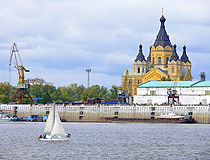
Alexander Nevsky Cathedral in Nizhny Novgorod
Author: Evgeniy Balashov
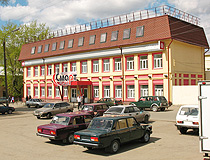
Shopping and office center Smart in Nizhny Novgorod
Author: Diman Lazarev
Sights of Nizhny Novgorod
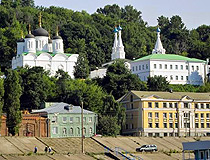
Annunciation Monastery - the oldest monastery in Nizhny Novgorod
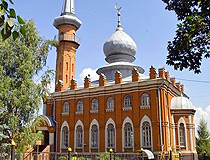
Nizhny Novgorod Cathedral Mosque
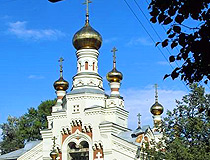
Church in honor of the icon of the Mother of God Joy of All Who Sorrow in Nizhny Novgorod
The comments of our visitors
- Currently 3.14/5
Rating: 3.1 /5 (250 votes cast)

IMAGES
VIDEO
COMMENTS
Our cruise control switch selection also offers our customers a number of choices. For more information about adding cruise control to your vehicle, contact us today. 12 of 12 Items. Sort By: $79.95. Add to Cart. $39.95. Add to Cart. $39.95.
Just press the gas pedal to bring your car up to the new speed, and hit the "SET" button again. This will set cruise control at the new speed. If your car has a +/- button for cruise control, press this when you want to raise or lower your car's speed. Part 2.
Cruise control light doesn't illuminate. One of most common symptoms of a problem with the cruise control switch is a cruise control light that will not illuminate. The light should be illuminated as soon as the cruise control system is switched on to notify the driver that the system is activated. If the light does not come on, that may be ...
Once the bolts have been removed, the cruise control switch is loose and you can remove it. Step 7: Disconnect the cruise control electrical harness. Step 8: Repeat the above step (s) with the other side cruise control switch. Step 9: Replace the old cruise control switch with the new one.
To set cruise control, press the ON/OFF button or switch. If you press this button again, it typically turns the system off. The Res + (resume / increase seed) button increases the cruising speed by 1 mph, while the Set - (set speed / reduce speed) button decreases it by 1 mph. To shut off the cruise control, you can press the Cancel button ...
You operate cruise control by either a stalk on the steering column or several buttons on the steering wheel. These include an on-off switch; a "set" button to select the speed you want the car to ...
Cruise Control Switch - Direct Fit, Sold individually. Part Number: RF50540002. 26 Reviews. Vehicle Info Required to Guarantee Fit. $14.37. 0. Add to Cart. Product Details. Notes : Blade type; 2-prong male terminal Warranty : 1-year Replacement unlimited-mileage warranty Quantity Sold : Sold individually.
The cruise control system controls the speed of your car the same way you do -- by adjusting the throttle position.But cruise control actuates the throttle valve by a cable connected to an actuator, instead of by pressing a pedal.The throttle valve controls the power and speed of the engine by limiting how much air the engine takes in (see How Fuel Injection Systems Work for more details).
Drive your vehicle to the test highway and accelerate to highway speeds. Step 4: Set your cruise control at 55 or 65 MPH. After the cruise control is set, slightly tap your brake pedal to verify the cruise control shuts off. Step 5: Reset the cruise control again and drive for 10 to 15 miles.
Cruise control not working in your vehicle? Today we're going over three main components of the cruise control system - The Cruise Control Main Switch, Cruse...
Cruise control is a feature allowing the driver to set a predetermined speed, which the system's computer maintains until the driver adjusts the speed, taps the brake, or disengages the system ...
Cruise control, also known as speed control, is an electronic system that allows you to maintain a specific speed without manually controlling the accelerator pedal. The system uses sensors and electronic components to control the throttle and keep your car moving at a desired speed.
1. Definition. Cruise control is an electronic system that allows a vehicle to maintain a consistent speed, without the need for continuous driver input on the accelerator pedal. 2. Activation. Cruise control systems are typically activated by pressing a button or switch located on the steering wheel or dashboard. 3. Function.
Honda Civic Cruise Control Switch. Ford F150 Cruise Control Switch. Chevrolet Silverado 1500 Cruise Control Switch. Toyota Camry Cruise Control Switch. Dodge Ram 1500 Cruise Control Switch. Toyota Corolla Cruise Control Switch. Chevrolet Cruze Cruise Control Switch. Show Less. Advice and How-To's.
The cruise control clutch release switch is located at the base of the clutch pedal and cuts off power to the cruise control system when the clutch pedal is depressed. This will disable the cruise control system and allow the engine to decelerate so that the driver can safely shift gears and slow down the vehicle.
Use a vacuum pump to apply vacuum to the dump hose to approximately 15 inches, and then press on the brake pedal. The vacuum should be dumped and the gauge should read 0. If the vacuum is not ...
The cruise control system uses an actuator which controls the accelerator allowing the car to continue driving at a set speed. The actuator is connected to the throttle via a cable. During cruise control, the cable is not just monitoring the car's speed but also the power of the engine. It ensures that the engine takes in the exact amount of ...
Rostra 250-1223 universal cruise control systems for cars, trucks, and SUVs. ... Any cruise control switch from Rostra will adapt to the Global Cruise system. Step 3: Providing Vehicle Speed Signal Part Number: Various. The Global Cruise system can adapt to pre-existing VSS input signals between 2,000 and 38,600 Pulses Per Mile (PPM).
The defective cruise control switch is disconnected and removed. The new cruise control switch is installed and connected. The air bag is reinstalled and the battery is reconnected. The cruise control switch is checked for proper installation. The vehicle is road tested to ensure proper operation of the cruise control switch.
Journal of Legal, Ethical and Regulatory Issues Volume 20, Issue 3, 2017
Those from the city who died in the war are commemorated at the Kremlin with a display of armoured vehicles typical of the era. 2. Get a sneak-peek into Nizhny Novgorod's pre-revolutionary literary world. Maksim Gorky, one of the most prominent Soviet writers, was born in Nizhny Novgorod.
Furthermore, Nizhny Novgorod is the Russia's largest center of river cruise tourism and venue of Nizhny Novgorod fair-based major international exhibitions. Nizhny Novgorod is one of the richest cultural centers of Russia. The most prominent artists have received education in the local theater and art schools. The city has opened a large ...
The historic part of the city is rich in sights and is a popular tourist destination. The population of Nizhny Novgorod is about 1,234,000 (2022), the area - 411 sq. km. The phone code - +7 831, the postal codes - 603000-603257. Local time in Nizhny Novgorod city is April 28, 6:20 am (+3 UTC).